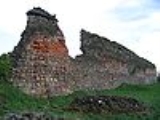
List of Brick Gothic buildings
Encyclopedia
Brick Gothic
is a style of Gothic architecture
widespread in the Northern Germany
and the Baltic region
. Its distinction from the preceding Brick Romanesque and succeeding Brick Renaissance is not always sharp. Often, Romanesque buildings were altered or added to in the Gothic style, others were begun while the Romanesque style prevailed, but completed in a Gothic fashion due to the slow building process. Such buildings can be classed equally with both styles.
The distribution of Brick Gothic is largely identical with the sphere of influence of the Hanseatic League
, with a preponderance in the younger cities east of the Elbe
. Besides urban representative buildings, cathedrals and churches, monasteries of the Mendicant Orders
and other communities, especially the Cistercians and the Premonstratensian
s, played an important role. Between Prussia
and Estonia
, the Teutonic Knights
erected brick Ordensburg
en.
This list does not aim to be complete. It does not attempt to list all of the thousands of Brick Gothic buildings that exist or once existed. Instead, it aims to list significant structures, buildings that are considered especially important for stylistic, functional, or other reasons. The main criterion is a building's being listed in art historical survey works on Brick Gothic and/or that its outstanding role has been referred to in individual scientific publications.
The dates given here refer to the present extant Gothic structures. Predecessors or post-Gothic alterations are not normally mentioned, but can be assessed by following up the literature. The most influential structures are indicated by bold print. Romanesque and Renaissance structures are not listed. Similarly, Gothic Brick structures from outside the Baltic or North German regions, e.g. the Danubian
ones, are omitted, as art historical terminology does not normally treat them as Brick Gothic
. Neogothic edifices are also not listed.
Belarus
Belgium
Denmark
Estonia
Finland
Schleswig-Holstein
Brandenburg
Lower Saxony
Latvia
Lithuania
Netherlands
Russia
Sweden
Ukraine
Brick Gothic
Brick Gothic is a specific style of Gothic architecture common in Northern Europe, especially in Northern Germany and the regions around the Baltic Sea that do not have natural rock resources. The buildings are essentially built from bricks...
is a style of Gothic architecture
Gothic architecture
Gothic architecture is a style of architecture that flourished during the high and late medieval period. It evolved from Romanesque architecture and was succeeded by Renaissance architecture....
widespread in the Northern Germany
Northern Germany
- Geography :The key terrain features of North Germany are the marshes along the coastline of the North Sea and Baltic Sea, and the geest and heaths inland. Also prominent are the low hills of the Baltic Uplands, the ground moraines, end moraines, sandur, glacial valleys, bogs, and Luch...
and the Baltic region
Baltic region
The terms Baltic region, Baltic Rim countries, and Baltic Rim refer to slightly different combinations of countries in the general area surrounding the Baltic Sea.- Etymology :...
. Its distinction from the preceding Brick Romanesque and succeeding Brick Renaissance is not always sharp. Often, Romanesque buildings were altered or added to in the Gothic style, others were begun while the Romanesque style prevailed, but completed in a Gothic fashion due to the slow building process. Such buildings can be classed equally with both styles.
The distribution of Brick Gothic is largely identical with the sphere of influence of the Hanseatic League
Hanseatic League
The Hanseatic League was an economic alliance of trading cities and their merchant guilds that dominated trade along the coast of Northern Europe...
, with a preponderance in the younger cities east of the Elbe
Elbe
The Elbe is one of the major rivers of Central Europe. It rises in the Krkonoše Mountains of the northwestern Czech Republic before traversing much of Bohemia , then Germany and flowing into the North Sea at Cuxhaven, 110 km northwest of Hamburg...
. Besides urban representative buildings, cathedrals and churches, monasteries of the Mendicant Orders
Mendicant Orders
The mendicant orders are religious orders which depend directly on the charity of the people for their livelihood. In principle, they do not own property, either individually or collectively , believing that this was the most pure way of life to copy followed by Jesus Christ, in order that all...
and other communities, especially the Cistercians and the Premonstratensian
Premonstratensian
The Order of Canons Regular of Prémontré, also known as the Premonstratensians, the Norbertines, or in Britain and Ireland as the White Canons , are a Catholic religious order of canons regular founded at Prémontré near Laon in 1120 by Saint Norbert, who later became Archbishop of Magdeburg...
s, played an important role. Between Prussia
Prussia
Prussia was a German kingdom and historic state originating out of the Duchy of Prussia and the Margraviate of Brandenburg. For centuries, the House of Hohenzollern ruled Prussia, successfully expanding its size by way of an unusually well-organized and effective army. Prussia shaped the history...
and Estonia
Estonia
Estonia , officially the Republic of Estonia , is a state in the Baltic region of Northern Europe. It is bordered to the north by the Gulf of Finland, to the west by the Baltic Sea, to the south by Latvia , and to the east by Lake Peipsi and the Russian Federation . Across the Baltic Sea lies...
, the Teutonic Knights
Teutonic Knights
The Order of Brothers of the German House of Saint Mary in Jerusalem , commonly the Teutonic Order , is a German medieval military order, in modern times a purely religious Catholic order...
erected brick Ordensburg
Ordensburg
An Ordensburg was a fortress built by crusading German military orders during the Middle Ages. "Ordensburg" was also used during Nazi Germany to refer to training schools for Nazi leaders.- Medieval Ordensburgen :...
en.
This list does not aim to be complete. It does not attempt to list all of the thousands of Brick Gothic buildings that exist or once existed. Instead, it aims to list significant structures, buildings that are considered especially important for stylistic, functional, or other reasons. The main criterion is a building's being listed in art historical survey works on Brick Gothic and/or that its outstanding role has been referred to in individual scientific publications.
The dates given here refer to the present extant Gothic structures. Predecessors or post-Gothic alterations are not normally mentioned, but can be assessed by following up the literature. The most influential structures are indicated by bold print. Romanesque and Renaissance structures are not listed. Similarly, Gothic Brick structures from outside the Baltic or North German regions, e.g. the Danubian
Danube
The Danube is a river in the Central Europe and the Europe's second longest river after the Volga. It is classified as an international waterway....
ones, are omitted, as art historical terminology does not normally treat them as Brick Gothic
Brick Gothic
Brick Gothic is a specific style of Gothic architecture common in Northern Europe, especially in Northern Germany and the regions around the Baltic Sea that do not have natural rock resources. The buildings are essentially built from bricks...
. Neogothic edifices are also not listed.
BelarusBelarusBelarus , officially the Republic of Belarus, is a landlocked country in Eastern Europe, bordered clockwise by Russia to the northeast, Ukraine to the south, Poland to the west, and Lithuania and Latvia to the northwest. Its capital is Minsk; other major cities include Brest, Grodno , Gomel ,...
| Place | Building | Main period of construction | Special features | Image |
| Kreva Kreva Kreva is a township in Hrodna Voblast, Belarus.-History:The Kreva Castle, constructed of brick, was built by the Grand Duke Gediminas of Lithuania at the borderland of Lithuanian ethnic lands. After his death in 1341, Kreva became the patrimony of his son and successor, Algirdas... |
Kreva Castle Kreva Castle Kreva Castle is the ruins of a major fortified residence of Grand Dukes Gediminas and Algirdas in Kreva village, Belarus. Algirdas's brother Kęstutis was imprisoned and murdered in Kreva Castle in 1382. The Act of Krewo, the first step towards the Commonwealth of Poland-Lithuania, was signed in... |
Early 14th century | Partially built of fieldstones |  |
| Lida Lida Lida is a city in western Belarus in Hrodna Voblast, situated 160 km west of Minsk. It is the fourteenth largest city in Belarus.- Etymology :... |
Lida Castle Lida Castle Lida Castle was one of several citadels erected by Grand Duke Gediminas of Lithuania in the early 14th century to defend his lands against the expansion of the Teutonic Knights. Other links in this chain of defense included Hrodna, Navahrudak, Kreva, Medininkai, and Trakai... |
14th century | Stone with brick superstructure | 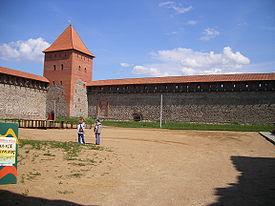 |
| Kamianiec Kamianiec Kamyanyets is a town in the Brest Voblast of Belarus and the center of the Kamenets Raion. The town is located in the northwestern corner of Brest voblast on the Liasnaja river, about 40 km north of Brest. As of 2002, the population was about 9,000 people... |
Tower | 1276–1289 | Border stronghold, one of the earliest brick constructions in the region |  |
| Mir Mir, Belarus Mir is an urban settlement in Kareličy raion, Hrodna Voblast, Belarus on the banks of Miranka River, about 85 kilometers southwest of the national capital, Minsk.... |
Mir Castle | Late 15th to early 16th | UNESCO World Heritage Site. Major Renaissance Renaissance The Renaissance was a cultural movement that spanned roughly the 14th to the 17th century, beginning in Italy in the Late Middle Ages and later spreading to the rest of Europe. The term is also used more loosely to refer to the historical era, but since the changes of the Renaissance were not... alterations |
|
BelgiumBelgiumBelgium , officially the Kingdom of Belgium, is a federal state in Western Europe. It is a founding member of the European Union and hosts the EU's headquarters, and those of several other major international organisations such as NATO.Belgium is also a member of, or affiliated to, many...
| Place | Building | Main period of construction | Special features | Image |
| Hoogstraten Hoogstraten Hoogstraten is a municipality located in the Belgian province of Antwerp. The municipality comprises the city of Hoogstraten proper and the towns of Meer, Meerle, Meersel-Dreef, Minderhout and Wortel,... |
St. Catharina Church | 1525-1550 | Built by Rombout Keldermans II. The tower was destroyed in 1944, but rebuilt after the war. The second highest church in Belgium (122,3m) | |
DenmarkDenmarkDenmark is a Scandinavian country in Northern Europe. The countries of Denmark and Greenland, as well as the Faroe Islands, constitute the Kingdom of Denmark . It is the southernmost of the Nordic countries, southwest of Sweden and south of Norway, and bordered to the south by Germany. Denmark...
| Place | Building | Main period of construction | Special features | Image |
| Aarhus Aarhus Aarhus or Århus is the second-largest city in Denmark. The principal port of Denmark, Aarhus is on the east side of the peninsula of Jutland in the geographical center of Denmark... |
Cathedral | End of 14th century to 1500 |  |
|
| Church of Our Lady Church of Our Lady (Aarhus) The Church of Our Lady is one of the largest churches of Århus, Denmark. It is situated in the centre of the city not far from Aarhus Cathedral . The church's crypt contains a stone church dating to 1060 AD.-History:... |
Mid-13th century to 1500 | |||
| Haderslev Haderslev Haderslev is a town and municipality on the east coast of the Jutland peninsula in south Denmark. Also included is the island of Årø as well as several other smaller islands in the Little Belt. The municipality covers and has a population of 56,414 . Its mayor is Jens Christian Gjesing,... |
Church of St. Mary | Mid-14th century to 1440 |  |
|
| Odense Odense The city of Odense is the third largest city in Denmark.Odense City has a population of 167,615 and is the main city of the island of Funen... |
Saint Canute's Cathedral Saint Canute's Cathedral St. Canute's Cathedral , also known as Odense Cathedral, is named after the Danish king Canute the Saint , otherwise Canute IV. It is a fine example of Brick Gothic architecture. The church's most visited section is the crypt where the remains of Canute and his brother Benedict are on display.-... |
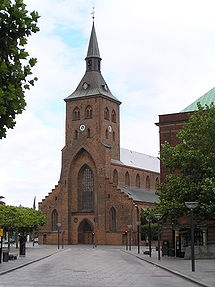 |
||
| Ribe Ribe Ribe , the oldest extant Danish town, is in southwest Jutland and has a population of 8,192 . Until 1 January 2007, it was the seat of both the surrounding municipality, and county... |
Cathedral | Built in 12th and 13th century of tufa Tufa Tufa is a variety of limestone, formed by the precipitation of carbonate minerals from ambient temperature water bodies. Geothermally heated hot-springs sometimes produce similar carbonate deposits known as travertine... , sandstone Sandstone Sandstone is a sedimentary rock composed mainly of sand-sized minerals or rock grains.Most sandstone is composed of quartz and/or feldspar because these are the most common minerals in the Earth's crust. Like sand, sandstone may be any colour, but the most common colours are tan, brown, yellow,... and granite Granite Granite is a common and widely occurring type of intrusive, felsic, igneous rock. Granite usually has a medium- to coarse-grained texture. Occasionally some individual crystals are larger than the groundmass, in which case the texture is known as porphyritic. A granitic rock with a porphyritic... (Romanesque Romanesque architecture Romanesque architecture is an architectural style of Medieval Europe characterised by semi-circular arches. There is no consensus for the beginning date of the Romanesque architecture, with proposals ranging from the 6th to the 10th century. It developed in the 12th century into the Gothic style,... ), later additions of brick |
 |
|
| Roskilde Roskilde Roskilde is the main city in Roskilde Municipality, Denmark on the island of Zealand. It is an ancient city, dating from the Viking Age and is a member of the Most Ancient European Towns Network.... |
Cathedral Roskilde Cathedral Roskilde Cathedral , in the city of Roskilde on the island of Zealand in eastern Denmark, is a cathedral of the Lutheran Church of Denmark. The first Gothic cathedral to be built of brick, it encouraged the spread of the Brick Gothic style throughout Northern Europe... |
12th to 13th century | UNESCO World Heritage Site. Essentially Romanesque but incorporating Gothic features. Among earliest large-scale brick edifices in northern Europe. | 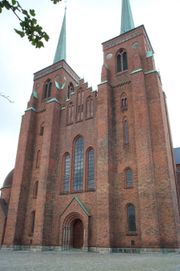 |
| Næstved | St. Peter's Church St. Peter's Church, Næstved St. Peter's Church in Næstved on the Danish island of Sealand is first mentioned in a monasterial letter from 1135. Built of red brick, it is one of Denmark's largest and finest Gothic buildings, scarcely altered since 1375. The chancel, with its five tall windows, is particularly impressive... |
12th to 14th century | Built on the site of an earlier Romanesque church, the Gothic church has scarcely been altered since 1375. | |
EstoniaEstoniaEstonia , officially the Republic of Estonia , is a state in the Baltic region of Northern Europe. It is bordered to the north by the Gulf of Finland, to the west by the Baltic Sea, to the south by Latvia , and to the east by Lake Peipsi and the Russian Federation . Across the Baltic Sea lies...
| Place | Building | Main period of construction | Special features | Image |
| Tartu Tartu Tartu is the second largest city of Estonia. In contrast to Estonia's political and financial capital Tallinn, Tartu is often considered the intellectual and cultural hub, especially since it is home to Estonia's oldest and most renowned university. Situated 186 km southeast of Tallinn, the... |
Cathedral Tartu Cathedral Tartu Cathedral , earlier also known as Dorpat Cathedral is one of the landmarks of the Estonian city of Tartu . The building is now an imposing ruin overlooking the lower town... |
15th century | Destroyed in Livonian War Livonian War The Livonian War was fought for control of Old Livonia in the territory of present-day Estonia and Latvia when the Tsardom of Russia faced a varying coalition of Denmark–Norway, the Kingdom of Sweden, the Union of the Grand Duchy of Lithuania and the Kingdom of Poland.During the period 1558–1578,... , east part of ruin now houses Tartu University University of Tartu The University of Tartu is a classical university in the city of Tartu, Estonia. University of Tartu is the national university of Estonia; it is the biggest and highest-ranked university in Estonia... Museum. Towers were originally 66 m high (now 22 m). |
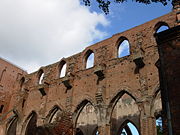 |
| St. John | Early 14th century | Numerous terracotta sculptures covering both the interior and the exterior. |  |
|
FinlandFinlandFinland , officially the Republic of Finland, is a Nordic country situated in the Fennoscandian region of Northern Europe. It is bordered by Sweden in the west, Norway in the north and Russia in the east, while Estonia lies to its south across the Gulf of Finland.Around 5.4 million people reside...
| Place | Building | Main period of construction | Special features | Image |
| Espoo Espoo Espoo is the second largest city and municipality in Finland. The population of the city of Espoo is . It is part of the Helsinki Metropolitan Area along with the cities of Helsinki, Vantaa, and Kauniainen. Espoo shares its eastern border with Helsinki and Vantaa, while enclosing Kauniainen.... |
Cathedral Espoo Cathedral The Espoo Cathedral is a medieval stone church in Espoo, Finland and the seat of the Diocese of Espoo of the Evangelical Lutheran Church of Finland. The cathedral is located in the district of Espoon keskus, near the Espoonjoki river... |
Parts in Brick Gothic | ||
| Halikko Halikko Halikko is a former municipality of Finland that existed until December 31, 2008. On January 1, 2009 the municipality was merged with the larger neighboring Salo. Before the merge Halikko had become a rapidly urbanizing rural area.... |
Holy (Saint) Bridget Bridget of Sweden Bridget of Sweden Bridget of Sweden Bridget of Sweden (1303 – 23 July 1373; also Birgitta of Vadstena, Saint Birgitta , was a mystic and saint, and founder of the Bridgettines nuns and monks after the death of her husband of twenty years... Church |
Portico in Brick Gothic |  |
|
| Hämeenlinna Hämeenlinna Hämeenlinna is a city and municipality of about inhabitants in the heart of the historical province of Häme in the south of Finland and is the birthplace of composer Jean Sibelius. Today, it belongs to the region of Tavastia Proper, and until 2010 it was the residence city for the Governor of the... |
Häme Castle Häme castle Häme Castle is a medieval castle in Hämeenlinna, Finland. The castle is located on the coast of lake Vanajavesi in the city center. The castle was originally located on an island.... |
14th and 15th century, on earlier fieldstone foundations | Brick castle | |
| Hattula Hattula Hattula is a municipality of Finland. Its seat is in Parola.It is part of the Tavastia Proper region and until 2010 it was located in the province of Southern Finland. The municipality has a population of and covers an area of ofwhich is water... |
Holy Cross Church | |||
| Porvoo Porvoo Porvoo is a city and a municipality situated on the southern coast of Finland approximately east of Helsinki. Porvoo is one of the six medieval towns in Finland, first mentioned as a city in texts from 14th century... |
Cathedral Porvoo Cathedral Porvoo cathedral is a cathedral in Porvoo, Finland. It was built in the 15th century, although the oldest parts date from the 13th century. It is used by the Evangelical Lutheran Church of Finland and is the seat of the Diocese of Borgå, Finland's Swedish-speaking diocese... |
 |
||
| Turku Turku Turku is a city situated on the southwest coast of Finland at the mouth of the Aura River. It is located in the region of Finland Proper. It is believed that Turku came into existence during the end of the 13th century which makes it the oldest city in Finland... |
Cathedral | 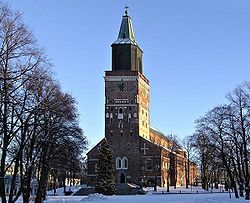 |
||
| Saint Mary's Church St Mary's Church, Turku St Mary's Church is a medieval stone church located in Maaria, in Turku, Finland. There are no records as to when the present church was built, but the work was probably started in the mid or late 15th century. According to Markus Hiekkanen, the church was probably built in the 1440s. On the basis... (Finnish: Maarian kirkko) |
||||
Mecklenburg-Vorpommern
| Place | Building | Main period of construction | Special features | Image |
| Altentreptow Altentreptow Altentreptow is a town in the Mecklenburgische Seenplatte district, in Mecklenburg-Western Pomerania, Germany. It is situated on the river Tollense, 15 km north of Neubrandenburg. Until 1939 the city's name was Treptow an der Tollense.... |
Petrikirche (St. Peter) | Mid-13th to 1st half 14th century | Hall church |  |
| City gates: Brandenburg Gate, Demmin Gate | Circa 1450 |  |
||
| Anklam Anklam Anklam is a town in the Western Pomerania region of Mecklenburg-Vorpommern, Germany. It is situated on the banks of the Peene river, just 8 km from its mouth in the Kleines Haff, the western part of the Stettin Lagoon. Anklam has a population of 14,603 and was the capital of the former... |
Marienkirche (St. Mary) | 2nd half 13th to late 14th century | Hall church Hall church A hall church is a church with nave and side aisles of approximately equal height, often united under a single immense roof. The term was first coined in the mid-19th century by the pioneering German art historian Wilhelm Lübke.... ; planned with two towers, not completed, thus asymmetric |
|
| Steintor (stone gate) | 13th/14th century | |||
| Nikolaikirche (St. Nicholas) | 14th century | Heavily damaged 1945, ruin restored, reconstruction in progress | ||
| Bad Doberan Bad Doberan Bad Doberan is a town in the district of Rostock, Mecklenburg-Vorpommern, Germany. It was the capital of the former district of Bad Doberan. As of 2010 its population was 11,325.-Geography:... |
Doberan Minster | Begun 1291, consecrated 1368 | Former Cistercian monastic church; basilica Basilica The Latin word basilica , was originally used to describe a Roman public building, usually located in the forum of a Roman town. Public basilicas began to appear in Hellenistic cities in the 2nd century BC.The term was also applied to buildings used for religious purposes... |
 |
| Bergen auf Rügen Bergen auf Rügen Bergen auf Rügen is the capital of the former district of Rügen in the middle of the island of Rügen in Mecklenburg-Vorpommern, Germany. Since 1 January 2005, Bergen has moreover been the administrative seat of the Amt of Bergen auf Rügen, which with a population of over 23,000 is... |
St. Marienkirche (St Mary) | Started 1180, consecrated 1193, renovated 1380 and after 1445 | Former monastic church of Benedictine or Cistercian nuns; basilica |  |
| Bützow Bützow Bützow is a town in the district of Rostock in Mecklenburg-Western Pomerania in Germany, with a population of 8,122 .The town was first mentioned in 1171.... |
Stiftskirche (abbey church) | Mid-13th to 2nd half 14th century | Hall church |  |
| Friedland | Marienkirche (St. Mary) | 1330 to early 15th century | Hall church |  |
| Greifswald Greifswald Greifswald , officially, the University and Hanseatic City of Greifswald is a town in northeastern Germany. It is situated in the state of Mecklenburg-Vorpommern, at an equal distance of about from Germany's two largest cities, Berlin and Hamburg. The town borders the Baltic Sea, and is crossed... |
Cathedral St. Nicholas | Mid 14th to 1st quarter 15th century | Basilica |  |
| St.-Marien-Kirche (St. Mary) | 1275–1340 | Hall church |  |
|
| St.-Jacobi-Kirche (St. James) | First mentioned 1280, renovation circa 1400 | Early Gothic hall church | 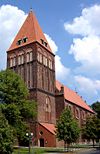 |
|
| House Markt 11 | Probably after 1400 | One of the most richly decorated Bürgerhäuser in North Germany |  |
|
| near Greifswald | Eldena Abbey Eldena Abbey Eldena Abbey , originally Hilda Abbey is a former Cistercian monastery near the present town of Greifswald in Mecklenburg-Vorpommern, Germany... |
Begun 1225, provisionally completed 1265, added to until 1350 | Former Cistercian monsatery; now ruin; favourite motif of Caspar David Friedrich Caspar David Friedrich Caspar David Friedrich was a 19th-century German Romantic landscape painter, generally considered the most important German artist of his generation. He is best known for his mid-period allegorical landscapes which typically feature contemplative figures silhouetted against night skies, morning... |
 |
| Güstrow Güstrow Güstrow is a town in Mecklenburg-Western Pomerania, Germany the capital of the district of Güstrow. It has a population of 30,500 and is the seventh largest town in Mecklenburg-Western Pomerania. Since 2006 Güstrow has the official suffix Barlachstadt.-Geography:The town of Güstrow is located... |
Cathedral St. Marien, St. Johannes Evangelist und St. Cecilia (St Mary, John the Evangelist and Cecilia) | Early 13th to late 15th century | Hall church |  |
| Marienkirche (St. Mary) | Gothic brick basilica |  |
||
| Malchin Malchin Malchin is a town in the Mecklenburgische Seenplatte district , in Mecklenburg-Western Pomerania, Germany.It offers some notable landmarks, such as two Brick Gothic town gates, a medieval defense tower, the Gothic town church of St. Johannis and the Neo Baroque town hall.-External links:*... |
St. Maria und St. Johannes (St. Mary and John) | From 1397 | Basilica | 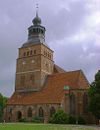 |
| Neubrandenburg Neubrandenburg Neubrandenburg is a city in Mecklenburg-Vorpommern, Germany. It is located in the southeastern part of the state, on the shore of a lake called the Tollensesee .... |
Marienkirche (St. Mary) | 2nd half 13th century |  |
|
| St. Johannes (St. John) | 1st half 14th century | Hall church, former Franciscan Franciscan Most Franciscans are members of Roman Catholic religious orders founded by Saint Francis of Assisi. Besides Roman Catholic communities, there are also Old Catholic, Anglican, Lutheran, ecumenical and Non-denominational Franciscan communities.... monastery |
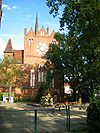 |
|
| Town fortifications, e.g. Stargard Gate, Treptow Gate, New Gate | After 1300 until early 15th century |  |
||
| Rostock Rostock Rostock -Early history:In the 11th century Polabian Slavs founded a settlement at the Warnow river called Roztoc ; the name Rostock is derived from that designation. The Danish king Valdemar I set the town aflame in 1161.Afterwards the place was settled by German traders... |
Marienkirche (St. Mary) St. Mary's Church, Rostock St. Mary's Church, Rostock, in German Marienkirche, is the biggest of three town churches found in the Hanseatic city of Rostock, in northern Germany. The other two are St. Petri and St. Nicholas . A fourth, St. James , was heavily damaged during the Second World War and subsequently demolished. St... |
Two building phases, after 1290 and after 1398 | Basilica; main church of Rostock |  |
| Nikolaikirche (St. Nicholas) | Present form after 1400 |  |
||
| Petrikirche (St. Peter) | Between 2nd quarter 14th and early 15th century |  |
||
| City Hall | Core around 1230, Gothic facade after 1300 | Since 1729 mostly obscured by Baroque structure |  |
|
| Kloster zum Heiligen Kreuz (Monastery of the Holy Cross) | 1st half 14th century | Former Cistercian nunnery | 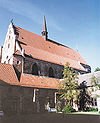 |
|
| Jakobikirche (St. James) | Damaged in World War II, demolished 1960 |  |
||
| House Kröpeliner Straße | Late 15th century | Former parsonage (now library) | 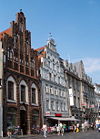 |
|
| Kerkhoff House | 3rd quarter 15th century | Bürgerhaus (now registry office) |  |
|
| City gates (incl. Steintor, Kröpelin Gate) | 13th to 16th century | 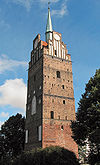 |
||
| Schwerin Schwerin Schwerin is the capital and second-largest city of the northern German state of Mecklenburg-Vorpommern. The population, as of end of 2009, was 95,041.-History:... |
Cathedral Schwerin Cathedral Schwerin Cathedral, as old as the city itself, dedicated to the Virgin Mary and Saint John, was built following the move of the seat of the Bishopric of the Abodrites, established by Henry the Lion, to Schwerin from Mecklenburg in the late 12th century. At first a timber construction served the... |
Circa 1280 to ca. 1420 | Basilica |  |
| Stralsund Stralsund - Main sights :* The Brick Gothic historic centre is a UNESCO World Heritage Site.* The heart of the old town is the Old Market Square , with the Gothic Town Hall . Behind the town hall stands the imposing Nikolaikirche , built in 1270-1360... |
Historic Centre | UNESCO World Heritage Site |  |
|
| Nikolaikirche (St. Nicholas) | About 1270 to early 15th century | Main church of Stralsund |  |
|
| City Hall | Several stages in 13th and 14th centuries | Most important profane urban building in Stralsund | 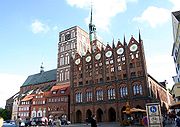 |
|
| Marienkirche (St. Mary) | 1382/84 to late 15th century | Second largest brick church in Hanseatic region, basilica |  |
|
| Jakobikirche (St. James) | Present structure started after 1300, altered after 1400 | Basilica |  |
|
| Johanniskloster (Abbey of St. John) | Early 14th century | Former Franciscan monastery; hall church | .jpg) |
|
| Wulflam House (Wulflamhaus) |  |
|||
| Katharinenkloster (Abbey of St. Catherine) | 2nd half 13th century | Former Dominican Dominican Order The Order of Preachers , after the 15th century more commonly known as the Dominican Order or Dominicans, is a Catholic religious order founded by Saint Dominic and approved by Pope Honorius III on 22 December 1216 in France... monastery |
.jpg) |
|
| Wismar Wismar Wismar , is a small port and Hanseatic League town in northern Germany on the Baltic Sea, in the state of Mecklenburg-Vorpommern,about 45 km due east of Lübeck, and 30 km due north of Schwerin. Its natural harbour, located in the Bay of Wismar is well-protected by a promontory. The... |
Historic Centre | UNESCO World Heritage Site |  |
|
| Georgenkirche (St. George) | Oldest part about 1300, completed in 15th century | One of the most important and most monumental structures in Baltic region |  |
|
| Nikolaikirche (St. Nicholas) | Present structure started after 1380, completed 2nd half 15th century | Basilica |  |
|
| Marienkirche (St. Mary) | Begun after 1339, completed in 15th century | After World War II damage dynamited in 1960, only tower survives. Was reputed to be one of the most beautiful churches in north Germany |  |
|
| Alter Schwede | Circa 1380 | Private House (now restaurant) |  |
|
| Archidiakonat (Archdeacons's House) | Mid 15th century | Private house |  |
|
| Wassertor (Water Gate) | 3rd quarter 15th century |  |
||
| Wolgast Wolgast Wolgast is a town in the district of Vorpommern-Greifswald, in Mecklenburg-Vorpommern, Germany. It is situated on the bank of the river Peenestrom, vis-a-vis the island of Usedom that can be accessed by road and railway via a bascule bridge... |
Petrikirche (St. Peter) | 1280–1350 | Basilica |  |
Schleswig-HolsteinSchleswig-HolsteinSchleswig-Holstein is the northernmost of the sixteen states of Germany, comprising most of the historical duchy of Holstein and the southern part of the former Duchy of Schleswig...
and HamburgHamburg-History:The first historic name for the city was, according to Claudius Ptolemy's reports, Treva.But the city takes its modern name, Hamburg, from the first permanent building on the site, a castle whose construction was ordered by the Emperor Charlemagne in AD 808...
| Place | Building | Main period of construction | Special features | Image |
| Cismar | Cismar Abbey Cismar Abbey Cismar Abbey was a Benedictine monastery located at Cismar near Grömitz, Schleswig-Holstein, in Germany.It was founded in 1238 by Count Adolf IV of Holstein as alternative accommodation for Benedictine monks from Lübeck. In the mid-15th century it was one of the six original members of the... |
13th century | Former Benedictine Benedictine Benedictine refers to the spirituality and consecrated life in accordance with the Rule of St Benedict, written by Benedict of Nursia in the sixth century for the cenobitic communities he founded in central Italy. The most notable of these is Monte Cassino, the first monastery founded by Benedict... monastery |
 |
| Eutin Eutin Eutin is the district capital of Eastern Holstein located in the northern German state of Schleswig-Holstein. As of 2005, it had some 17,000 inhabitants.... |
St.-Michaelis-Kirche (St. Michael) | 1st third 13th century, altered in 14th and 15th centuries |  |
|
| Flensburg Flensburg Flensburg is an independent town in the north of the German state of Schleswig-Holstein. Flensburg is the centre of the region of Southern Schleswig... |
Nikolaikirche (St. Nicholas) | Two phases, between 1390 and 1480 |  |
|
| Hamburg Hamburg -History:The first historic name for the city was, according to Claudius Ptolemy's reports, Treva.But the city takes its modern name, Hamburg, from the first permanent building on the site, a castle whose construction was ordered by the Emperor Charlemagne in AD 808... |
St. Petri St. Petri, Hamburg The St. Peter's Church ] in Hamburg was built on top of many churches. It was built by order of Pope Leo the Tenth.-History:... (St. Peter) |
 |
||
| St. Katharinen St. Catherine's Church, Hamburg St. Catherine's Church is one of the five principal Lutheran churches of Hamburg, Germany. The base of its spire, dating from the 13th century, is the oldest building preserved in the city; after the lighthouse on Neuwerk island... (St. Catherine) |
 |
|||
| St. Jacobi St. Jacobi, Hamburg The St. Jacobi church is one of the five principal Lutheran churches of Hamburg, Germany. The church is located directly in the city center, has a 125 m tall tower and features a famous organ by Arp Schnitger from 1693. It is dedicated to St James the Greater and often incorrectly known in English... (St. James) |
 |
|||
| Lübeck Lübeck The Hanseatic City of Lübeck is the second-largest city in Schleswig-Holstein, in northern Germany, and one of the major ports of Germany. It was for several centuries the "capital" of the Hanseatic League and, because of its Brick Gothic architectural heritage, is listed by UNESCO as a World... |
Historic Centre | UNESCO World Heritage Site |  |
|
| Marienkirche St. Mary's Church, Lübeck The Lutheran Marienkirche in Lübeck was constructed between 1250 and 1350. For many years it has been a symbol of the power and prosperity of the old Hanseatic city, and as Germany's third largest church it remains the tallest building of the old part of Lübeck. It is larger than Lübeck Cathedral... (St. Mary) |
From 1251, completed late 14th century | Basilica; most influential Brick Gothic building | ||
| City Hall | Main building 1340–50, so-called Langes Haus 1298–1308, Kriegsstubenbau 1442–44 | One of the most important profane buildings in Brick Gothic |  |
|
| Cathedral Lübeck Cathedral The Lübeck Cathedral is a large brick Lutheran cathedral in Lübeck, Germany and part of Lübeck's world heritage. It was started in 1173 by Henry the Lion as a cathedral for the Bishop of Lübeck. It was partly destroyed in a bombing raid in World War II , and later reconstructed. The organ by Arp... |
Foundation laid in 1173 by Henry the Lion Henry the Lion Henry the Lion was a member of the Welf dynasty and Duke of Saxony, as Henry III, from 1142, and Duke of Bavaria, as Henry XII, from 1156, which duchies he held until 1180.... , consecrated 1247, Gothic alterations from 1266 until 15th century |
 |
||
| Holstentor Holstentor The Holsten Gate is a city gate marking off the western boundary of the old center of the Hanseatic city of Lübeck. This Brick Gothic construction is one of the relics of Lübeck’s medieval city fortifications and the only remaining city gate, except for the Citadel Gate... |
1466–78, major additions later |  |
||
| Burgtor Burgtor The Burgtor, built 1444 in late Gothic style, was the northern city gate of Hanseatic Lübeck, now in Germany. It is one of two towered gates remaining from the medieval fortifications, the other being the more famous Holstentor.... |
 |
|||
| Petrikirche (St. Peter) | Several phases, late 13th to 15th century | 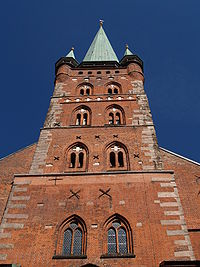 |
||
| Jakobikirche (St. James) | After 1276 to 1334 | 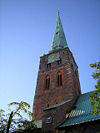 |
||
| Aegidienkirche (St. Aegidius) | 1st half 14th century | 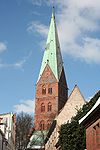 |
||
| Katharinenkirche (St. Catherine) | 1300–1330 | Former Franciscan monastic church |  |
|
| Heiligen-Geist-Hospital (Hospital of the Holy Spirit) | Circa 1276 bis 1286 |  |
||
| Burgkloster | After 1276 to 1401 | Former Dominican monastery, modern additions |  |
|
| St.-Annen-Kloster Lübeck (Monastery of St. Anne) | Former Augustinian nunnery, damaged by fire in 1843 |  |
||
| Kanzleigebäude (Chancellery) | Built 1484, enlarged 1588 and 1614 |  |
||
| Meldorf Meldorf Meldorf is a city in western Schleswig-Holstein, in the district of Dithmarschen, and straddling the Miele river. It was first mentioned in writing before 1250 ad, and it served as the capital of the Dithmarschen, a peasant republic with Allies in the Hanseatic league dating from 1468... |
Sankt-Johannis-Kirche (St. John) | 1230–1300 |  |
|
| Schleswig | St.-Petri (Cathedral) Schleswig Cathedral Schleswig Cathedral , officially the Cathedral of St. Peter at Schleswig , is the main church of Schleswig and was the cathedral of the Bishop of Schleswig until the diocese was dissolved in 1624... (St. Peter) |
1275–1320 |  |
|
BrandenburgBrandenburgBrandenburg is one of the sixteen federal-states of Germany. It lies in the east of the country and is one of the new federal states that were re-created in 1990 upon the reunification of the former West Germany and East Germany. The capital is Potsdam...
, BerlinBerlinBerlin is the capital city of Germany and is one of the 16 states of Germany. With a population of 3.45 million people, Berlin is Germany's largest city. It is the second most populous city proper and the seventh most populous urban area in the European Union...
and Saxony-AnhaltSaxony-AnhaltSaxony-Anhalt is a landlocked state of Germany. Its capital is Magdeburg and it is surrounded by the German states of Lower Saxony, Brandenburg, Saxony, and Thuringia.Saxony-Anhalt covers an area of...
| Place | Building | Main period of construction | Special features | Image |
| Bad Wilsnack Bad Wilsnack Bad Wilsnack is a town in the Prignitz district, in Brandenburg, Germany. It is situated halfway between Berlin and Hamburg. Since 1928 it has been officially recognised as a spa town, before which time its name was simply Wilsnack... |
Wunderblutkirche St. Nikolai (Church of the Holy Blood Holy Blood of Wilsnack The Holy Blood Wilsnack were three allegedly miraculous hosts, which survived a fire in 1383 that burned the church and village to the ground. The relics became the destination of medieval religious pilgrimages to Bad Wilsnack, Germany for nearly two centuries. Revenue from the many pilgrims... ) |
Main pilgrimage Pilgrimage A pilgrimage is a journey or search of great moral or spiritual significance. Typically, it is a journey to a shrine or other location of importance to a person's beliefs and faith... in North Germany |
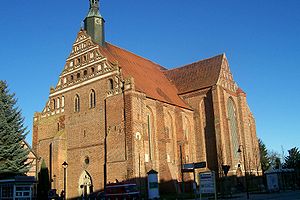 |
|
| Berlin Berlin Berlin is the capital city of Germany and is one of the 16 states of Germany. With a population of 3.45 million people, Berlin is Germany's largest city. It is the second most populous city proper and the seventh most populous urban area in the European Union... |
St. Marienkirche (St. Mary) |  |
||
| Nikolaikirche Nikolaikirche (Berlin) The Church of St. Nicholas is the oldest church in Berlin, the capital of Germany. The church is located in the eastern part of central Berlin, the borough of Mitte... (St. Nicholas) |
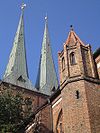 |
|||
| Graues Kloster (Grey Abbey) | End of 13th century | Former Franciscan abbey; ruined since World War II |  |
|
| Brandenburg | St.-Katharinenkirche (St. Catherine) | Two phases after 1401 |  |
|
| Cathedral St. Peter and Paul | Main period of construction 1165–1240 | First brick church in Margraviate of Brandenburg Margraviate of Brandenburg The Margraviate of Brandenburg was a major principality of the Holy Roman Empire from 1157 to 1806. Also known as the March of Brandenburg , it played a pivotal role in the history of Germany and Central Europe.... |
 |
|
| Former Marienkirche (St. Mary) | Built circa 1220, demolished 1722 | Formerly important pilgrimage church |  |
|
| Chorin Chorin Chorin is a municipality in the district of Barnim in Brandenburg, Germany. It is most famous for its cloister and for being situated within the Schorfheide-Chorin Biosphere Reserve. It is famous for its medieval Brick Gothic Chorin Abbey .... |
Chorin Abbey | Former Cistercian monastery |  |
|
| Doberlug-Kirchhain Doberlug-Kirchhain Doberlug-Kirchhain is a town in the district of Elbe-Elster, Brandenburg, Germany. -History:937. The town of Kirchhain was built by Margrave Gero. A document written in 1005 mentions the town Doberlug for the first time. In 1165 the Cistercian Dobrilugk Abbey was founded by Margrave Dietrich of... |
Dobrilugk Abbey Dobrilugk Abbey Dobrilugk Abbey was a Cistercian monastery in Lower Lusatia in the territory of the present town of Doberlug-Kirchhain, Brandenburg, Germany.-History:... |
Former Cistercian monastery | .jpg) |
|
| Frankfurt (Oder) Frankfurt (Oder) Frankfurt is a town in Brandenburg, Germany, located on the Oder River, on the German-Polish border directly opposite the town of Słubice which was a part of Frankfurt until 1945. At the end of the 1980s it reached a population peak with more than 87,000 inhabitants... |
Marienkirche (St. Mary) | 1253–1367, choir completed 1367, additions in 15th century |  |
|
| Town hall | Begun 1253, altered in 14th century |  |
||
| Havelberg Havelberg Havelberg is a town in the district of Stendal, in Saxony-Anhalt, Germany. It is situated on the Havel, and part of the town is built on an island in the centre of the river. The two parts were incorporated as a town in 1875... |
Cathedral St. Marien (St. Mary) |  |
||
| Jüterbog Jüterbog Jüterbog is a historic town in north-eastern Germany, located in the Teltow-Fläming district of Brandenburg. It is located on the Nuthe river at the northern slope of the Fläming hill range, about southwest of Berlin.-History:... |
Town hall | |||
| Mönchenkloster (monastery) |  |
|||
| Jüterbog Jüterbog Jüterbog is a historic town in north-eastern Germany, located in the Teltow-Fläming district of Brandenburg. It is located on the Nuthe river at the northern slope of the Fläming hill range, about southwest of Berlin.-History:... -Zinna |
Zinna Abbey Zinna Abbey Zinna Abbey is a former Cistercian monastery, the site of which is now occupied by a village also called Kloster Zinna, today part of Jüterbog in Brandenburg, Germany, about south of Berlin.- Cistercians :... |
Mainly from 1220 | Former Cistercian monastery |  |
| Lehnin Lehnin Kloster Lehnin or Lehnin is a municipality in the German state of Brandenburg, about southeast of Brandenburg an der Havel.-Overview:It was established on April 1, 2002 by the merger of 13 villages:... |
Lehnin Abbey Lehnin Abbey Lehnin Abbey is a former Cistercian monastery in Lehnin in Brandenburg, Germany. Since 1911 it has accommodated the Luise-Henrietten-Stift, a Protestant women's community.-History:... |
From end of 12th century, consecrated 1262 or 1270 | 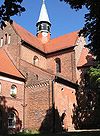 |
|
| Prenzlau Prenzlau Prenzlau , a city in the Uckermark District of Brandenburg in Germany, had a population of about 21,000 in 2005.-International relations:Prenzlau is twinned with: Uster, Switzerland Barlinek, Poland Świdwin, Poland... |
Marienkirche (St. Mary) |  |
||
| Salzwedel Salzwedel Salzwedel of Altmarkkreis Salzwedel, and has a population of approximately 21,500. Salzwedel is located on the German Framework Road.-Geography:... |
Church St. Marien; St. Katharinen |  |
||
| Local courthouse (former town hall) |  |
|||
| Fortifications(Steintor, Neuperver Tor) |  |
|||
| Stendal Stendal Stendal is a town in Saxony-Anhalt, Germany. It is the capital of Stendal District and unofficial capital of the Altmark. Its population in 2001 was 38,900. It is located some west of Berlin and around east of Hanover... |
Marienkirche (St. Mary) |  |
||
| Cathedral St. Nikolaus (St. Nicholas) | 1423 to mid-15th century | |||
| Town hall | Gothic part early 15th century |  |
||
| Fortifications (Tangermünde GateTor, Uenglingen Gate) |  |
|||
| Tangermünde Tangermünde Tangermünde is a town in the district of Stendal, in the northeastern part of Saxony-Anhalt, Germany. It is situated on the Elbe river in the Altmark region.-History:Tangermünde can look back at an 1000-year history... |
Town hall | Circa 1430 |  |
|
| Stephanskirche (St. Stephen) | 14th century | |||
| Fortifications | 14th to 15th century |  |
||
Lower SaxonyLower SaxonyLower Saxony is a German state situated in north-western Germany and is second in area and fourth in population among the sixteen states of Germany...
and BremenBremenThe City Municipality of Bremen is a Hanseatic city in northwestern Germany. A commercial and industrial city with a major port on the river Weser, Bremen is part of the Bremen-Oldenburg metropolitan area . Bremen is the second most populous city in North Germany and tenth in Germany.Bremen is...
| Place | Building | Main period of construction | Special features | Image |
| Bardowick Bardowick Bardowick is a municipality in the district of Lüneburg in Lower Saxony, Germany. It is three miles north of Lüneburg on the navigable river Ilmenau. Bardowick is also the seat of the Samtgemeinde Bardowick.-History:The town was first mentioned in AD 795 and was raised to city status in AD 972 by... |
Cathedral St. Peter and Paul | 1389–1485 |  |
|
| Braunschweig Braunschweig Braunschweig , is a city of 247,400 people, located in the federal-state of Lower Saxony, Germany. It is located north of the Harz mountains at the farthest navigable point of the Oker river, which connects to the North Sea via the rivers Aller and Weser.... |
Liberei (library) | 1413–1422 | Oldest surviving library building north of the Alps |  |
| Bremen Bremen The City Municipality of Bremen is a Hanseatic city in northwestern Germany. A commercial and industrial city with a major port on the river Weser, Bremen is part of the Bremen-Oldenburg metropolitan area . Bremen is the second most populous city in North Germany and tenth in Germany.Bremen is... |
Cathedral Bremen Cathedral Bremen Cathedral , dedicated to St. Peter, is a church situated in the market square in the center of Bremen, in northern Germany. The cathedral belongs to the Bremian Evangelical Church, a member of the Protestant umbrella organisation named Evangelical Church in Germany... |
13th century |  |
|
| St. Martini (St. Martin) | Late Gothic |  |
||
| City hall | 1405–1410; 1608–1612 altered in style of Weser Renaissance Weser Renaissance Weser Renaissance is a form of Renaissance architectural style that is found in the area around the River Weser in central Germany and which has been well-preserved in the towns and cities of the region.- Background :... |
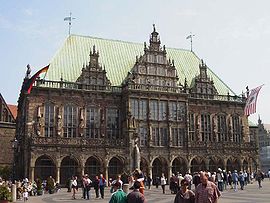 |
||
| Ebstorf Ebstorf Ebstorf is a municipality in the district of Uelzen, in Lower Saxony, Germany. It is situated approx. 12 km northwest of Uelzen, and 25 km south of Lüneburg.... |
Ebstorf Abbey | 14th century | Premonstratensian, later Benedictine Benedictine Benedictine refers to the spirituality and consecrated life in accordance with the Rule of St Benedict, written by Benedict of Nursia in the sixth century for the cenobitic communities he founded in central Italy. The most notable of these is Monte Cassino, the first monastery founded by Benedict... monastery |
 |
| Fürstenau Fürstenau, Germany Fürstenau is a municipality in the district of Osnabrück, in Lower Saxony, Germany. It is situated approximately northwest of Osnabrück, and east of Lingen.Fürstenau is also the seat of the Samtgemeinde Fürstenau.... |
Börstel Abbey | Mid-13th century onwards | Former Cistercian nunnery |  |
| Hanover Hanover Hanover or Hannover, on the river Leine, is the capital of the federal state of Lower Saxony , Germany and was once by personal union the family seat of the Hanoverian Kings of Great Britain, under their title as the dukes of Brunswick-Lüneburg... |
Marktkirche Marktkirche The Marktkirche , officially Marktkirche S. Georgii et Jacobi, dedicated to St. George and St. James, is the main Lutheran church in Hanover. It was built in the 14th century and, together with the nearby Old Town Hall, is considered the southernmost example of the "North German brick gothic" ... (market church) |
14th century |  |
|
| Hude Hude Hude is a municipality in the district of Oldenburg, in Lower Saxony, Germany. It is situated 15 km east of Oldenburg, and 25 km west of Bremen . The population is approximately 15000 and roughly one third of these people are retired.... |
Hude Abbey | 13th century | Now ruin |  |
| Leer Leer Leer is a town in the district of Leer, the northwestern part of Lower Saxony, Germany. It is situated at the river Ems, near the border with the Netherlands.... (East Frisia East Frisia East Frisia or Eastern Friesland is a coastal region in the northwest of the German federal state of Lower Saxony.... ) |
Harderwykenburg Harderwykenburg The Harderwykenburg is one of the oldest extant castles of East Frisia. It was built in the style of a medieval stone house soon after 1450 in Leer, Lower Saxony, Germany.... |
Circa 1450 | Fortified house, whitewashed |  |
| Lüneburg Lüneburg Lüneburg is a town in the German state of Lower Saxony. It is located about southeast of fellow Hanseatic city Hamburg. It is part of the Hamburg Metropolitan Region, and one of Hamburg's inner suburbs... |
St. Johannis (St. John) | 1300–1370 | ||
| Town hall | 1st half to end 13th century |  |
||
| Michaeliskirche | Circaum 1375 | |||
| Nikolaikirche (St. Nicholas) | 1407–1440 | 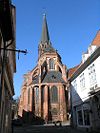 |
||
| Marienhafe Marienhafe Marienhafe is a municipality in the district of Aurich, in Lower Saxony, Germany.... |
Marienkirche (St. Mary) | 13th century | Formerly triple-naved church with 80-m tower doubling as landmark for shipping, in 1829 tower reduced and part of church demolished for financial reasons |  |
| Verden | Cathedral | 1290–1323 and 1473–1490 | Romanesque predecessor from 12th century |  |
| Wienhausen Wienhausen Wienhausen is a municipality in the district of Celle, in Lower Saxony, Germany. It is known for Wienhausen Abbey, referenced in the municipal coat of arms.... |
Wienhausen Abbey | 13th and 14th century | Cistercian nunnery |  |
LatviaLatviaLatvia , officially the Republic of Latvia , is a country in the Baltic region of Northern Europe. It is bordered to the north by Estonia , to the south by Lithuania , to the east by the Russian Federation , to the southeast by Belarus and shares maritime borders to the west with Sweden...
| Place | Building | Main period of construction | Special features | Image |
| Riga Riga Riga is the capital and largest city of Latvia. With 702,891 inhabitants Riga is the largest city of the Baltic states, one of the largest cities in Northern Europe and home to more than one third of Latvia's population. The city is an important seaport and a major industrial, commercial,... |
Historic Centre | UNESCO World Heritage Site |  |
|
| Cathedral | 13th century |  |
||
| St. Peter St. Peter's Church, Riga St. Peter's Church is a tall Lutheran church in Riga, Latvia, named after Saint Peter.-History:First mention of the St. Peter's Church is in records dating to 1209. The church was a masonry construction and therefore undamaged by a city fire in Riga that year... |
13th to 15th century | 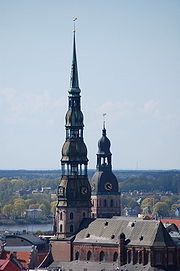 |
||
| St James | 13th century |  |
||
| St. John | 15th century | formerly Dominican |  |
|
| House of the Blackheads House of the Blackheads House of the Blackheads is a building situated in the old town of Riga, Latvia. The original building was erected during the first third of the 14th century for the Brotherhood of Blackheads, a guild for unmarried German merchants in Riga... |
late 14th century with 19th century additions | Destroyed in World War II and rebuilt in 1995 |  |
|
| Turaida Turaida Turaida is a part of Sigulda in the Vidzeme Region of Latvia. Its most famous site is the Brick Gothic Turaida Castle.-External links:*... |
Castle Turaida Castle Turaida Castle is a recently reconstructed medieval castle in Turaida, in the Vidzeme region of Latvia, on the opposite bank of the Gauja River from Sigulda.... |
14th century | 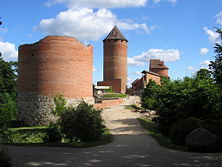 |
|
LithuaniaLithuaniaLithuania , officially the Republic of Lithuania is a country in Northern Europe, the biggest of the three Baltic states. It is situated along the southeastern shore of the Baltic Sea, whereby to the west lie Sweden and Denmark...
| Place | Building | Main period of construction | Special features | Image |
| Vilnius Vilnius Vilnius is the capital of Lithuania, and its largest city, with a population of 560,190 as of 2010. It is the seat of the Vilnius city municipality and of the Vilnius district municipality. It is also the capital of Vilnius County... |
St. Anne's St. Anne's Church, Vilnius St. Anne's Church is a Roman Catholic church in Vilnius' Old Town, on the right bank of the Vilnia River. It is a prominent example of both Flamboyant Gothic and Brick Gothic styles. St... |
1495–1500 | Highly exceptional use of Late Gothic flamboyant style |  |
| St. Francis | 15th century and later repairs |  |
||
| St. Nicholas St. Nicholas Church, Vilnius St. Nicholas Church is the oldest surviving church in Lithuania, built in the Old Town of the capital city Vilnius. Originally built in the 14th century, it is mentioned in wiritng for the first time in 1387. Archaeologists believe that the same Roman Catholic church survived till the present day... |
Late 14th century | The oldest surviving church building in Lithuania | 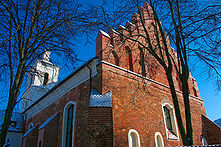 |
|
| Gediminas Tower Gediminas Tower Gediminas' Tower is the only remaining part of the Upper Castle in Vilnius, Lithuania.The first fortifications were built of wood by Duke of the Grand Duchy of Lithuania, Gediminas. Later the first brick castle was completed in 1409 by Grand Duke Vytautas... and Upper Castle Vilnius Castle Complex The Vilnius Castle Complex , is a group of cultural, and historic structures on the left bank of the Neris River, near its confluence with the Vilnia River, in Vilnius, Lithuania. The buildings, which evolved between the 10th and 18th centuries, were one of Lithuania's major defensive... |
Early 15th century, many later alterations | Built by Grand Duke of Lithuania Vytautas | .jpg) |
|
| Kaunas Kaunas Kaunas is the second-largest city in Lithuania and has historically been a leading centre of Lithuanian economic, academic, and cultural life. Kaunas was the biggest city and the center of a powiat in Trakai Voivodeship of the Grand Duchy of Lithuania since 1413. During Russian Empire occupation... |
Cathedral Kaunas Cathedral Basilica Kaunas Cathedral Basilica is a Roman Catholic cathedral basilica in Kaunas, Lithuania.The exact date when the first Gothic style church dedicated to apostles Saint Peter and Saint Paul, was built is unknown, but it was first mentioned in written sources in 1413. The first parochial school in... |
Construction from 1408 onwards | Basilica, the largest Gothic church in Lithuania | 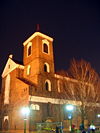 |
| Castle Kaunas Castle Kaunas Castle is located in Kaunas, Lithuania. Archeological evidence suggests that it was originally built during the mid-14th century, in the Gothic style. Its site is strategic – a rise on the banks of the Nemunas River near its confluence with the Neris River... |
Construction from mid-14th century onwards | The oldest brick castle in Lithuania | 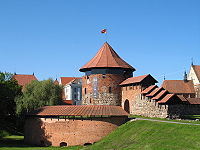 |
|
| St. Gertrude Church of St. Gertrude, Kaunas Church of St. Gertrude is located in the Old Town of Kaunas and is one of the oldest Brick Gothic churches in Lithuania. Located just off Laisvės alėja , the church is somewhat hidden away and can be accessed from Laisves aleja through a gate at a hotel which is located nearby the Court building... |
15th century? | 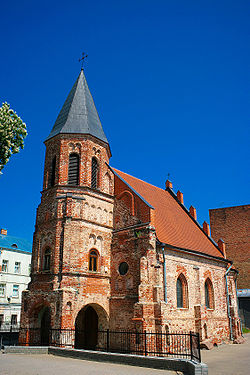 |
||
| Church of The Accession of The Holy Virgin Vytautas' the Great Church Vytautas' the Great Church of the Assumption of The Holy Virgin Mary is a Roman Catholic church in the Old Town of Kaunas, Lithuania, and is one of the oldest churches in the city.-History:... |
Circa 1400 | Former Franciscan, unique Latin cross layout |  |
|
| House of Perkūnas House of Perkunas House of Perkūnas is one of the most original and archaic Gothic secular buildings, located in the Old Town of Kaunas, Lithuania. Originally built by Hanseatic merchants and served as their office from 1440 till 1532, it was sold in the 16th century to the Jesuits who had established a chapel there... |
Late 15th century | The most archaic residential Gothic building in Lithuania |  |
|
| Medininkai | Castle Medininkai Castle Medininkai Castle , a medieval castle in Vilnius district, Lithuania, was built in the late 13th century or the first quarter of the 14th century. The defensive perimeter of the castle was 6.5 hectares; it is the largest enclosure type castle in Lithuania.... |
13th century | The only surviving enclosure type castle and the largest in Lithuania |  |
| Trakai Trakai Trakai is a historic city and lake resort in Lithuania. It lies 28 km west of Vilnius, the capital of Lithuania. Because of its proximity to Vilnius, Trakai is a popular tourist destination. Trakai is the administrative centre of Trakai district municipality. The town covers 11.52 km2 of... |
Island Castle Trakai Island Castle Trakai Island Castle is an island castle located in Trakai, Lithuania on an island in Lake Galvė. The castle is sometimes referred to as "Little Marienburg". The construction of the stone castle was begun in the 14th century by Kęstutis, and around 1409 major works were completed by his son... |
14th - early 15th century | Built by Grand Dukes of Lithuania Kęstutis Kestutis Kęstutis was monarch of medieval Lithuania. He was the Duke of Trakai and governed the Grand Duchy of Lithuania, 1342–82, together with his brother Algirdas , and with his nephew Jogaila... and Vytautas. |
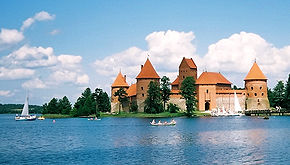 |
| Peninsula Castle Trakai Peninsula Castle Trakai Peninsula Castle is one of the castles in Trakai, Lithuania. It is located on a peninsula between southern Lake Galvė and Lake Luka. Built around 1350–1377 by Kęstutis, Duke of Trakai, it was an important defensive structure protecting Trakai and Vilnius, capital of the Grand Duchy of... |
Late 14th century and later repairs | Built by Grand Duke of Lithuania Kęstutis Kestutis Kęstutis was monarch of medieval Lithuania. He was the Duke of Trakai and governed the Grand Duchy of Lithuania, 1342–82, together with his brother Algirdas , and with his nephew Jogaila... |
 |
|
| Zapyškis | St. John The Baptist church | 1578 | The only surviving rural Gothic church in Lithuania |  |
NetherlandsNetherlandsThe Netherlands is a constituent country of the Kingdom of the Netherlands, located mainly in North-West Europe and with several islands in the Caribbean. Mainland Netherlands borders the North Sea to the north and west, Belgium to the south, and Germany to the east, and shares maritime borders...
| Place | Building | Main period of construction | Special features | Image |
| Delft Delft Delft is a city and municipality in the province of South Holland , the Netherlands. It is located between Rotterdam and The Hague.... |
Oude Kerk (Old Church) Oude Kerk (Delft) The Oude Kerk , nicknamed Oude Jan , is a Gothic Protestant church in the old city center of Delft, the Netherlands. Its most recognizable feature is a 75-meter-high brick tower that leans about two meters from the vertical.... |
Founded in 1246 | 75 m brick tower, now leaning ca.2 m from the vertical | 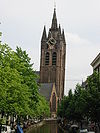 |
Northern Poland
| Place | Building | Main period of construction | Special features | Image |
| Bartoszyce Bartoszyce Bartoszyce is a town on the Łyna River in northeastern Poland with 25,621 inhabitants . It is the capital of Bartoszyce County within the Warmian-Masurian Voivodeship.-History:... |
St. John the Evangelist | 14th-15th century | ||
| Braniewo Braniewo Braniewo is a town in northeastern Poland, in the Warmian-Masurian Voivodeship, with a population of 18,068 . It is the capital of Braniewo County... |
St. Catherine | Badly damaged in World War II, rebuilt afterwards | ||
| Brodnica Brodnica Brodnica is a town in northern Poland with 27,400 inhabitants . Previously part of Toruń Voivodeship [a province], from 1975 to 1998, Brodnica has been situated in the Kuyavian-Pomeranian Voivodeship since 1999... |
St. Catherine | 14th century | ||
| Chełmno | St. Mary | 1290–1333 |  |
|
| St. Peter and Paul | Built in 13th century, altered in 14th | Former Dominican church |  |
|
| St. Jacob and Nicholas | Built in 13th and 14th century | Former Franciscan church | ||
| Teutonic Knights Teutonic Knights The Order of Brothers of the German House of Saint Mary in Jerusalem , commonly the Teutonic Order , is a German medieval military order, in modern times a purely religious Catholic order... fortifications |
14th-15th century |  |
||
| Chojna Chojna Chojna is a small town in western Poland in the West Pomeranian Voivodeship. It lies approximately 60 km south of Szczecin and participates in the Douzelage.... |
Town hall | 15th century | 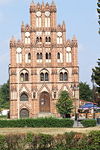 |
|
| St. Mary | Mainly 1389–1459 |  |
||
| Dobre Miasto Dobre Miasto Dobre Miasto is a town in Poland, in Olsztyn County in the Warmian-Masurian Voivodeship. It has 10,579 inhabitants . It is situated in the northwestern part of the Masurian Lake District in the heart of the historical region Warmia... |
Collegial Church |  |
||
| Elbląg Elblag Elbląg is a city in northern Poland with 127,892 inhabitants . It is the capital of Elbląg County and has been assigned to the Warmian-Masurian Voivodeship since 1999. Before then it was the capital of Elbląg Voivodeship and a county seat in Gdańsk Voivodeship... |
St. Nicholas | 13th century, in 15th century converted from basilica to hall church | burnt out 1945 |  |
| Frombork Frombork Frombork is a town in northern Poland, on the Vistula Lagoon, in Braniewo County, Warmian-Masurian Voivodeship. It had a population of 2,528 as of 2005.... |
Cathedral Cathedral A cathedral is a Christian church that contains the seat of a bishop... |
1343–1383 |  |
|
| Gdańsk Gdansk Gdańsk is a Polish city on the Baltic coast, at the centre of the country's fourth-largest metropolitan area.The city lies on the southern edge of Gdańsk Bay , in a conurbation with the city of Gdynia, spa town of Sopot, and suburban communities, which together form a metropolitan area called the... |
St. Mary's Church St. Mary's Church, Gdansk St. Mary's Church or, properly, Basilica of the Assumption of the Blessed Virgin Mary is a Roman Catholic church in Gdańsk, Poland, which is the largest brick church in the world. It was begun in 1379. St. Mary's Church (Polish: Bazylika Mariacka, German: Marienkirche) or, properly, Basilica of... |
1343–1502 | One of the largest Brick Gothic edifices | 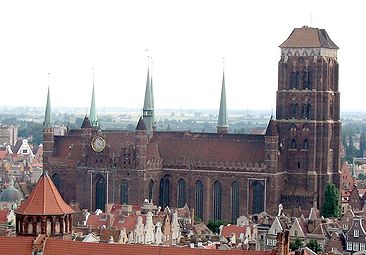 |
| St. Catherine's | probably 14th and 15th century |  |
||
| St. Nicholas | 1348-early 15th century | Dominican church |  |
|
| Church of Holy Trinity with former Franciscan monastery | 1481–1514 | |||
| St. George guildhall | 1487-94 | |||
| Great Mill | 14th century |  |
||
| Crane Gate | 1442–1444 | 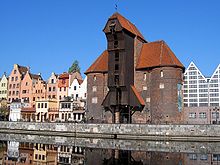 |
||
| Gniew Gniew Gniew is a town situated on the left bank of the Vistula River, in the Pomeranian Voivodeship, Poland. It is located at around .-History:The first recorded mentions of Gniew appear in written documents from the first half of the 13th century, one of which refers to the region as Terra Gymeu... |
Teutonic Knights Ordensburg | Late 13th to 14th century |  |
|
| Kamień Pomorski Kamien Pomorski Kamień Pomorski is a town in the West Pomeranian Voivodeship of northwestern Poland. The capital of Kamień County, the town had 9,129 inhabitants as of June 30, 2008.- History :... |
Cathedral of St. John | Circa 1175, altered in 15th century | Romanesque-Gothic Basilica |  |
| Kołobrzeg | Cathedral of St. Mary | 1288–1397 |  |
|
| Kwidzyn Kwidzyn Kwidzyn is a town in northern Poland on the Liwa river, with 40,008 inhabitants . It has been a part of the Pomeranian Voivodeship since 1999, and was previously in the Elbląg Voivodeship . It is the capital of Kwidzyn County.-History:... |
Castle and Cathedral complex | 14th and 15th century |  |
|
| Lidzbark Warmiński Lidzbark Warminski Lidzbark Warmiński is a town in the Warmian-Masurian Voivodeship in Poland. It is the capital of Lidzbark County.- History :The town was originally an Old Prussian settlement known as Lecbarg until being conquered in 1240 by the Teutonic Knights, who called it Heilsberg... |
Episcopal Castle/Ordensburg | One of the earliest brick buildings in the area | ||
| Malbork Malbork Malbork is a town in northern Poland in the Żuławy region , with 38,478 inhabitants . Situated in the Pomeranian Voivodeship since 1999, it was previously assigned to Elbląg Voivodeship... |
Malbork Castle Malbork Castle The Marienburg Castle in Malbork is by area the largest castle in the world. It was built in Prussia by the Teutonic Knights, a German Roman Catholic religious order of crusaders, in a form of an Ordensburg fortress. The Order named it Marienburg... (Ordensburg Ordensburg An Ordensburg was a fortress built by crusading German military orders during the Middle Ages. "Ordensburg" was also used during Nazi Germany to refer to training schools for Nazi leaders.- Medieval Ordensburgen :... ) |
1276 to late 14th century | UNESCO World Heritage Site, the Marienburg Ordensburg Ordensburg An Ordensburg was a fortress built by crusading German military orders during the Middle Ages. "Ordensburg" was also used during Nazi Germany to refer to training schools for Nazi leaders.- Medieval Ordensburgen :... is the largest non-religious Brick Gothic structure. Teutonic Knights Teutonic Knights The Order of Brothers of the German House of Saint Mary in Jerusalem , commonly the Teutonic Order , is a German medieval military order, in modern times a purely religious Catholic order... headquarter since 1309. 1380s enlargements by Nikolaus von Fellenstein (see Neman, Russia). |
.jpg) |
| Nidzica Nidzica Nidzica is a town in the Warmian-Masurian Voivodeship in Poland, between Olsztyn and Mława. It has a population of 14,798 . It is the capital of Nidzica County.-History:... |
Ordensburg | 14th and 15th century |  |
|
| Olsztyn Olsztyn Olsztyn is a city in northeastern Poland, on the Łyna River. Olsztyn has been the capital of the Warmian-Masurian Voivodeship since 1999. It was previously in the Olsztyn Voivodeship... |
Castle of the Cathedral Chapter Chapter (religion) Chapter designates certain corporate ecclesiastical bodies in the Roman Catholic, Anglican and Nordic Lutheran churches.... |
2nd half 14th century | Ordensburg Ordensburg An Ordensburg was a fortress built by crusading German military orders during the Middle Ages. "Ordensburg" was also used during Nazi Germany to refer to training schools for Nazi leaders.- Medieval Ordensburgen :... ; converted to castle in 15th and 16th centuries |
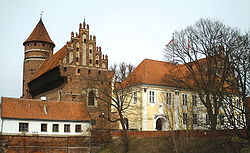 |
| St. James Cathedral | Before 1445 | Late Gothic Hall church |  |
|
| Orneta Orneta Orneta is a town in northern Poland, in the Warmian-Masurian Voivodeship, with a population of 9,859 .- History :Wormditt, a village of Old Prussians, was first mentioned in 1308... |
Cathedral of St. John | 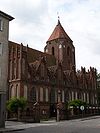 |
||
| Pelplin Pelplin Pelplin is a small town in Tczew County, Pomeranian Voivodship, Poland. Population: 9,993 . The former Pelplin Abbey is the seat of the Roman Catholic Diocese of Pelplin, and the abbey church is now Pelpin Cathedral.It is located at around .... |
Cathedral | 13th to 14th century, later alterations | former Cistercian monastery |  |
| Radzyń Chełmiński | Ordensburg | 13th and 14th century | Ruin |  |
| Stargard Szczeciński Stargard Szczecinski Stargard Szczeciński is a city in northwestern Poland, with a population of 71,017 . Situated on the Ina River it is the capital of Stargard County and since 1999 has been in the West Pomeranian Voivodeship; prior to that it was in the Szczecin Voivodeship... |
St. Mary's St. Mary's Church, Stargard Szczecinski The Church of the Blessed Virgin Mary, Queen of the World in Stargard Szczeciński is perhaps the most valuable architectural monument in Polish Western Pomerania. It closes the eastern part of the Old Town Market.-History:... |
13th century origins, 1388-1500 additions | 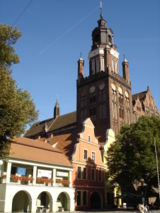 |
|
| Brama Młyńska (Mill Gate) | 15th century | One of only two survuving examples of such gates (see Waterpoort Waterpoort The Waterpoort or Hoogendster Pijp is a water gate, a gate in a defensive wall that connects a city to a waterway. It is situated in Sneek, the Netherlands.In the 15th and 16th century, a defensive wall had been built around Sneek... at Tweek) |
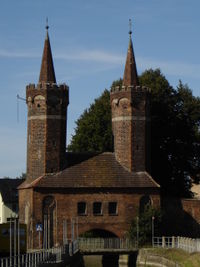 |
|
| Szczecin Szczecin Szczecin , is the capital city of the West Pomeranian Voivodeship in Poland. It is the country's seventh-largest city and the largest seaport in Poland on the Baltic Sea. As of June 2009 the population was 406,427.... |
Cathedral of St. James | Several phases between 1375 and 1504 | ||
| St. John | 13th to 15th century, 19th century renovations | |||
| City hall | 15th century |  |
||
| Sztum Sztum Sztum is a town in northern Poland, located in the Pomeranian Voivodeship. It is the capital of Sztum County, with some 10,141 inhabitants .-History:... |
Ordensburg and town | Early 14th century | One of strongest Teutonic Knights castle in the area. Much damage by fires in 1683 and 1945. | 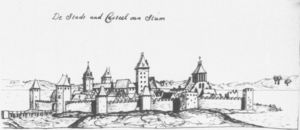 |
| Toruń Torun Toruń is an ancient city in northern Poland, on the Vistula River. Its population is more than 205,934 as of June 2009. Toruń is one of the oldest cities in Poland. The medieval old town of Toruń is the birthplace of the astronomer Nicolaus Copernicus.... |
Historic Centre | 13th to 15th century | UNESCO World Heritage Site; churches, town hall, houses and granaries from 13th-15th century |  |
| Cathedral of St. John the Baptist and St. John the Evangelist Cathedral Basilica of St. John the Baptist and St. John the Evangelist, Torun Church of St. John the Baptist and St. John the Evangelist, since 1935 Minor Basilica, since 1992 the Cathedral of Toruń Diocese, former main parish church of Old Town of Toruń. One of three gothic churches of the town, built from brick, an aisled hall with a monumental west tower. The first church... |
14th and 15th century | Former parish church of Toruń's Old Town | ||
| St. Mary's Church | 1350–1370 | Former Franciscan Franciscan Most Franciscans are members of Roman Catholic religious orders founded by Saint Francis of Assisi. Besides Roman Catholic communities, there are also Old Catholic, Anglican, Lutheran, ecumenical and Non-denominational Franciscan communities.... hall church |
 |
|
| St. Jacob's church | 1309-about 1340 | Parish church of Toruń's New Town | ||
| Town hall | 13th-14th century, rebuild in 17th century |  |
||
| Teutonic Knights Ordensburg | 13th to early 15th century |  |
||
Central Poland
| Place | Building | Main period of construction | Special features | Image |
| Borysławice Zamkowe | Castle | c. 1425 | Destroyed by Swedish-Brandenburg Brandenburg Brandenburg is one of the sixteen federal-states of Germany. It lies in the east of the country and is one of the new federal states that were re-created in 1990 upon the reunification of the former West Germany and East Germany. The capital is Potsdam... ian forces during the Deluge, currently in ruins |
|
| Brochów Brochów, Masovian Voivodeship Brochów is a village in Sochaczew County, Masovian Voivodeship, east-central Poland. It is the seat of Gmina Brochów and lies some north of Sochaczew and west of Warsaw.... |
Fortified church | 1551–1561, 1596 | Gothic-renaissance Renaissance The Renaissance was a cultural movement that spanned roughly the 14th to the 17th century, beginning in Italy in the Late Middle Ages and later spreading to the rest of Europe. The term is also used more loosely to refer to the historical era, but since the changes of the Renaissance were not... church established by Jan Brochowski and his family as a three-nave Nave In Romanesque and Gothic Christian abbey, cathedral basilica and church architecture, the nave is the central approach to the high altar, the main body of the church. "Nave" was probably suggested by the keel shape of its vaulting... church with three side towers |
|
| Brześć Kujawski Brzesc Kujawski Brześć Kujawski is a town in the Kuyavian-Pomeranian Voivodeship, Population - 4,521 , Poland.It has been the seat of one of two small duchies into which Kuyavia has been temporarily divided.... |
St. Stanisław Church | after 1332, 15th century | ||
| Bydgoszcz | Bernardine Church | 1552–1557 | Late Gothic | |
| Cathedral of St. Martin and St. Nicolas | 1425–1502 | |||
| Ciechanów Ciechanów Ciechanów is a town in north-central Poland with 45,900 inhabitants . It is situated in Masovian Voivodeship . It was previously the capital of Ciechanów Voivodeship.-History:The grad numbered approximately 3,000 armed men.... |
Masovian Dukes Castle | 14th century | Destroyed by Swedish-Brandenburgian forces during the Deluge, currently in ruins | |
| Czersk Czersk, Masovian Voivodeship Czersk is a settlement in the administrative district of Gmina Góra Kalwaria, within Piaseczno County, Masovian Voivodeship, in east-central Poland. It lies approximately south-east of Góra Kalwaria, south-east of Piaseczno, and south-east of Warsaw.... |
Masovian Dukes Castle | 1388–1410 | Destroyed by Swedish-Brandenburgian forces during the Deluge, currently in ruins | |
| Czerwińsk | Abbey Church | 12th century | Romanesque, the facade was rebuilt in gothic style in the second half of the 15th century |  |
| Gate of Abbot Kula | 1457 | |||
| Drzewice Drzewice Drzewice is the north-western borough of the town of Kostrzyn nad Odrą in western Poland. Until 1952 it was but a village. During World War II Stalag III-C Alt-Drewitz, a Nazi POW camp, was located there.... |
Church of St. Lucas | 1321–1460 | ||
| Maciej Drzewicki Castle | 1527–1535 | Gothic-renaissance, upper parts in brick, rest sandstone and brick, currently in ruins | ||
| Gniezno Gniezno Gniezno is a city in central-western Poland, some 50 km east of Poznań, inhabited by about 70,000 people. One of the Piasts' chief cities, it was mentioned by 10th century A.D. sources as the capital of Piast Poland however the first capital of Piast realm was most likely Giecz built around... |
Cathedral Gniezno Cathedral Cathedral Basilica of the Assumption of the Blessed Virgin Mary and St. Adalbert is a Gothic cathedral in Gniezno, Poland. The Cathedral is known for its twelfth-century , two-winged bronze doors decorated with scenes of martyrdom of St. Wojciech and a silver relic coffin of that saint... |
1342–1415, north tower completed 1512 | The basilica Basilica The Latin word basilica , was originally used to describe a Roman public building, usually located in the forum of a Roman town. Public basilicas began to appear in Hellenistic cities in the 2nd century BC.The term was also applied to buildings used for religious purposes... type church, baroquified in the 17th century |
|
| Gostyń Gostyn Gostyń is a town in Greater Poland Voivodeship , in Gostyń County. According to 30 June 2004 data its population was 20,746.-Geography:Gostyń is located at 17°01' East and 51°53' North.... |
St. Margaret's Church | 14th century | ||
| Koło | Royal Castle | before 1362 | Destroyed by Swedish-Brandenburgian forces during the Deluge, currently in ruins | |
| Konin Konin Konin is a city in central Poland.Konin may also refer to:*Emperor Kōnin , emperor of Japan who reigned 770–781**Kōnin , a Japanese era name for the years 810–824... |
St. Bartholomew's Church | 14th century | 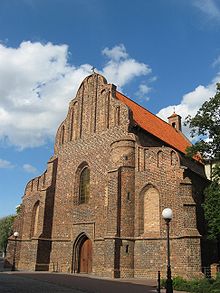 |
|
| Kruszwica Kruszwica Kruszwica is a town in central Poland and is situated in the Kuyavian-Pomeranian Voivodeship , previously in Bydgoszcz Voivodeship .It has a population of 9,412 people .-History:... |
Castle | 1350–1355 | Destroyed by Swedish-Brandenburgian forces during the Deluge, only the legendary Mouse Tower preserved | |
| Liw Liw Liw is a village in the administrative district of Gmina Liw, within Węgrów County, Masovian Voivodeship, in east-central Poland. It lies on the river Liwiec , approximately west of Węgrów and east of Warsaw.... |
Masovian Dukes Castle | before 1429 | Destroyed by Swedish-Brandenburgian forces during the Deluge, currently in ruins | |
| Lubiń Lubin, Koscian County Lubiń is a village in the administrative district of Gmina Krzywiń, within Kościan County, Greater Poland Voivodeship, in west-central Poland. It lies approximately east of Krzywiń, south-east of Kościan, and south of the regional capital Poznań.... |
Abbey Church | 15th-16th century | Baroquified in the 18th century | |
| Lublin Lublin Lublin is the ninth largest city in Poland. It is the capital of Lublin Voivodeship with a population of 350,392 . Lublin is also the largest Polish city east of the Vistula river... |
Cracow Gate | 14th century | Partially rebuilt in the 18th century | |
| Royal Castle Lublin Castle The Lublin Castle is a medieval castle situated in Lublin, Poland, adjacent to the Old Town district and close to the city center. It is one of the oldest preseved Royal residencies in Poland, established by king Casimir II the Just.-History:... |
13th-14th century | Destroyed by Swedish-Brandenburgian forces during the Deluge, inside the Castle Chapel profuse ruthenian fresco Fresco Fresco is any of several related mural painting types, executed on plaster on walls or ceilings. The word fresco comes from the Greek word affresca which derives from the Latin word for "fresh". Frescoes first developed in the ancient world and continued to be popular through the Renaissance... s from the beginning of th 15th century, founded by Jogaila Jogaila Jogaila, later 'He is known under a number of names: ; ; . See also: Jogaila : names and titles. was Grand Duke of Lithuania , king consort of Kingdom of Poland , and sole King of Poland . He ruled in Lithuania from 1377, at first with his uncle Kęstutis... |
||
| Łęczyca | Royal Castle | 1357–1370 | ||
| Łomża | Cathedral | 1504–1525 | Late Masovian Gothic | |
| Oporów | Bishop Castle | 1434–1449 | Built for Władysław Oporowski Władysław Oporowski Władysław Oporowski was a Polish medieval political and religious leader. Deputy Chancellor of Poland , Bishop of Kujawy , archbishop of Gniezno and primate of Poland... , Bishop of Kujawy and Archbishop of Gniezno |
|
| Piotrków Trybunalski Piotrków Trybunalski Piotrków Trybunalski is a city in central Poland with 80,738 inhabitants . It is situated in the Łódź Voivodeship , and previously was the capital of Piotrków Voivodeship... |
Royal Castle Piotrków Trybunalski Castle The Piotrków Trybunalski Royal Castle is a Gothic-Renaissance structure in Piotrków Trybunalski, Poland. It was built in the form of a residential tower in the 16th century and was transformed into a museum open to the public in 1919.-History:... |
1512–1519 | Gothic-renaissance | .jpg) |
| Płock | Masovian Dukes Castle | 14th century | ||
| Płock Cathedral towers | 13th-14th century | Romanesque cathedral, rebuilt several times | ||
| Poznań Poznan Poznań is a city on the Warta river in west-central Poland, with a population of 556,022 in June 2009. It is among the oldest cities in Poland, and was one of the most important centres in the early Polish state, whose first rulers were buried at Poznań's cathedral. It is sometimes claimed to be... |
Basilica of St. Peter and St. Paul | 14th and 15th century | One of the oldest churches in Poland and the oldest Polish cathedral, partially rebuilt in the 18th century | |
| Corpus Christi Church | 1406, 1465–1470 | Church founded by Jogaila, partially rebuilt in the 18th century | ||
| House of Psalterists | 1518 | Building founded by Jan Lubrański, bishop of Poznań |  |
|
| St. Mary's Church in summo | 1431–1448 | The first church was founded by Dobrawa of Bohemia in 965 | ||
| Przasnysz Przasnysz Przasnysz is a town in Poland. Located in the Masovian Voivodship, about 110 km north of Warsaw and about 115 km south of Olsztyn, it's the capital of Przasnysz County. It has 18,093 inhabitants . One of the most important towns in Mazovia during the Middle Ages. City laws - 1427.-Famous... |
Church of St. John and St. Anne | 1588–1618 | Considered to be the last gothic church in Poland | |
| Rawa Mazowiecka Rawa Mazowiecka Rawa Mazowiecka is a town in central Poland, with 17,765 inhabitants . It lies in the Łódź Voivodeship and is the capital of Rawa County.First mentioned in 1288, it received city rights in 1321.... |
Masovian Dukes Castle | 14th century | Destroyed by Swedish-Brandenburgian forces during the Deluge, currently in ruins | |
| Sieradz Sieradz Sieradz is a town on the Warta river in central Poland with 44,326 inhabitants . It is situated in the Łódź Voivodship , but was previously the eponymous capital of the Sieradz Voivodship , and historically one of the minor duchies in Greater Poland.It is one of the oldest towns in Poland,... |
Collegiate | 1370 | Baroquified in the 17th century | |
| Supraśl Suprasl Supraśl is a town in north-eastern Poland. It is the home of the Supraśl Lavra, one of only six Eastern Orthodox monasteries for males in Poland. Situated in the Podlaskie Voivodeship , previously in Białystok Voivodeship . It is located in Białystok County, about 15 km northeast of... |
Orthodox Monastery Suprasl Orthodox Monastery The Monastery of the Annunciation in Supraśl , also known as the Supraśl Lavra is a monastery in North Eastern Poland in the Podlaskie Voivodeship... - Church of the Annunciation |
1503–1511 | Gothic-renaissance Renaissance The Renaissance was a cultural movement that spanned roughly the 14th to the 17th century, beginning in Italy in the Late Middle Ages and later spreading to the rest of Europe. The term is also used more loosely to refer to the historical era, but since the changes of the Renaissance were not... , blown up in 1944 by retreating German army, rebuilt since 1985 |
 |
| Szamotuły | Collegiate | 1423–1430 | ||
| Środa Wielkopolska Sroda Wielkopolska Środa Wielkopolska is a town in central Poland, about southeast of Poznań, with 22,001 inhabitants .-Overview:It is situated in Greater Poland Voivodeship, having previously been in the former Poznań Voivodeship... |
Church | 15th century | Partially rebuilt in the 16th century (attic) | |
| Uniejów Uniejów Uniejów is a town in Poddębice County, Łódź Voivodeship, Poland, with 2,960 inhabitants .-External links:**... |
Archbishop Castle | 1360–1365 | Built for Jarosław Bogoria-Skotnicki, Archbishop of Gniezno |  |
| Warsaw Warsaw Warsaw is the capital and largest city of Poland. It is located on the Vistula River, roughly from the Baltic Sea and from the Carpathian Mountains. Its population in 2010 was estimated at 1,716,855 residents with a greater metropolitan area of 2,631,902 residents, making Warsaw the 10th most... |
St. John's Cathedral St. John's Cathedral, Warsaw St. John's Archcathedral in Warsaw is a Catholic church in Warsaw's Old Town, is the only one archcathedral in Warszawa, the other 3 are cathedrals in the Polish capital. St. John's stands immediately adjacent to Warsaw's Jesuit church, and is one of the oldest churches in the city and the main... |
14th century | Completely destroyed by German artillery during the Warsaw Uprising Warsaw Uprising The Warsaw Uprising was a major World War II operation by the Polish resistance Home Army , to liberate Warsaw from Nazi Germany. The rebellion was timed to coincide with the Soviet Union's Red Army approaching the eastern suburbs of the city and the retreat of German forces... , rebuilt 1947-1957 in Masovian Brick Gothic |
 |
| St. Mary's Church St. Mary's Church, Warsaw The Church of the Visitation of the Most Blessed Virgin Mary , otherwise known as St. Mary's Church is a church in Warsaw, Poland. It is one of oldest buildings and one of the few surviving examples of Gothic architecture in the city. It is located at ulica Przyrynek 2.-History:St. Mary's Church... |
1410–1411 | Completely destroyed by German artillery during the World War II, rebuilt 1947-1966 |  |
|
| Warsaw Barbican Warsaw Barbican The Warsaw barbican is a barbican in Warsaw, Poland, and one of few remaining relics of the complex network of historic fortifications that once encircled Warsaw. Located between the Old and New Towns, it is a major tourist attraction.-History:The barbican was erected in 1540 in place of an older... |
1548 | reconstructed 1952–1954 | ||
| Bridge Gate Stara Prochownia Stara Prochownia also known as the Bridge Gate is a historic building in Warsaw New Town. It is located on ulica Boleść, just below the New Town and the Barbican, on the Vistula River escarpment.-History:... |
1584, additions in 18th century | Gothic-renaissance gate. |  |
|
| Wieluń Wielun Wieluń is a city in central Poland with 24,347 inhabitants . Situated in the Łódź Voivodeship , it was previously in Sieradz Voivodeship .- History :... |
Cracow Gate | 14th century | In the 19th century the town authorities adapted the building for a town hall | |
| Włocławek | Cathedral | 14th and 15th century | Rebuilt 1883-1901 in neo-Gothic style | |
| Wschowa Wschowa Wschowa is a town in the Lubusz Voivodeship in Poland with 14,607 inhabitants . It is the capital of Wschowa County.-History:Wschowa was originally a border fortress in a region disputed by the Polish dukes of Silesia and Greater Poland. After German colonists had established a settlement nearby,... |
City Church | 15th century | Baroquified between 1720–1726 | |
Southern Poland
| Place | Building | Main period of construction | Special features | Image |
| Biecz Biecz Biecz is a town and municipality in southeastern Poland, in Lesser Poland Voivodeship, Gorlice County. It is in the Carpathian Mountains, in the Doły Jasielsko Sanockie, by the Ropa River... |
Corpus Christi Church | c. 1326-1480 | ||
| Bell Tower | 15th century | Upper parts - mannerist Mannerism Mannerism is a period of European art that emerged from the later years of the Italian High Renaissance around 1520. It lasted until about 1580 in Italy, when a more Baroque style began to replace it, but Northern Mannerism continued into the early 17th century throughout much of Europe... sgraffito Sgraffito Sgraffito is a technique either of wall decor, produced by applying layers of plaster tinted in contrasting colors to a moistened surface, or in ceramics, by applying to an unfired ceramic body two successive layers of contrasting slip, and then in either case scratching so as to produce an... decorations |
||
| Bochnia Bochnia Bochnia is a town of 30,000 inhabitants on the river Raba in southern Poland. The town lies approximately in halfway [] between Tarnów and the regional capital Kraków . Bochnia is most noted for its salt mine, the oldest functioning in Europe, built circa 1248... |
St. Nicolas' Church | 1440–1445 | ||
| Chęciny Checiny Chęciny is a town in Kielce County, Świętokrzyskie Voivodeship, Poland, with 4,252 inhabitants .The town is first mentioned in historical documents from 1275. It obtained its city charter in 1325. The most important sight in the town is the royal castle built in the late 13th or early 14th century... |
Chęciny Castle Checiny Castle The Chęciny Royal Castle was built in the late 13th century in Chęciny, Poland. It fell into ruin in the 18th century and remains in that state to this day.-History:... |
13th or 14th century | Upper parts in brick, rest limestone. Destroyed by Swedish-Brandenburgian forces during the Deluge, currently in ruins | |
| Dębno Debno, Brzesko County Dębno is a village in Brzesko County, Lesser Poland Voivodeship, in southern Poland. It is the seat of the gmina called Gmina Dębno. It lies approximately east of Brzesko and east of the regional capital Kraków.... |
Jakub Dembiński Castle | 15th century | ||
| Kraków Kraków Kraków also Krakow, or Cracow , is the second largest and one of the oldest cities in Poland. Situated on the Vistula River in the Lesser Poland region, the city dates back to the 7th century. Kraków has traditionally been one of the leading centres of Polish academic, cultural, and artistic life... |
Barbican of Kraków Barbican of Kraków The Kraków barbican is a barbican – a fortified outpost once connected to the city walls. It is a historic gateway leading into the Old Town of Kraków, Poland. The barbican is one of the few remaining relics of the complex network of fortifications and defensive barriers that once encircled the... |
1498–1499 | ||
| Collegium Maius Collegium Maius The Collegium Maius , in Kraków, Poland, is the Jagiellonian University's oldest building, dating back to the 15th century. It stands at the corner of ulica Jagiellońska and ulica Świętej Anny The Collegium Maius (Latin for "Great College"), in Kraków, Poland, is the Jagiellonian University's... |
15th century | 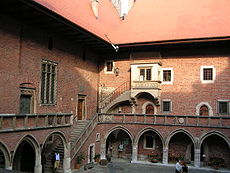 |
||
| Corpus Christi Church | 1385–1405 | |||
| Church of the Trinity | 14th and 15th century, rebuilt after 1850 fire | Former Dominican church | ||
| Florian Gate Florian Gate St. Florian's Gate or Florian Gate in Kraków, Poland, is one of the best-known Polish Gothic towers, and a focal point of Kraków's Old Town. It was built about the 14th century as a rectangular Gothic tower of "wild stone", part of the city fortifications against Turkish attack.-History:The tower,... |
Early 14th century | Upper parts in brick, rest limestone |  |
|
| St. Catherine Church | 1342–1426 |  |
||
| Old Synagogue Old Synagogue (Kraków) Old Synagogue is an Orthodox Jewish synagogue in Kazimierz district of Kraków, Poland. It is the oldest synagogue building still standing in Poland, and one of the most precious landmarks of Jewish architecture in Europe... |
1407 or 1492 |  |
||
| St. Mary's Basilica St. Mary's Basilica, Kraków St. Mary's Basilica , is a Brick Gothic church re-built in the 14th century , adjacent to the Main Market Square in Kraków, Poland... |
1321–1331, 14th-15th century | Hall church |  |
|
| Town Hall Tower Town Hall Tower, Kraków Town Hall Tower in Kraków, Poland is one of the main focal points of the Main Market Square in the Old Town district of Kraków.The Tower is the only remaining part of the old Town Hall demolished in 1820 as part of the city plan to open up the Main Square... |
End of the 13th century |  |
||
| Wawel Castle Wawel Castle The Gothic Wawel Castle in Kraków in Poland was built at the behest of Casimir III the Great and consists of a number of structures situated around the central courtyard. In the 14th century it was rebuilt by Jogaila and Jadwiga of Poland. Their reign saw the addition of the tower called the Hen's... |
13th-16th century | Wawel Wawel Wawel is an architectural complex erected over many centuries atop a limestone outcrop on the left bank of the Vistula River in Kraków, Poland, at an altitude of 228 metres above the sea level. It is a place of great significance to the Polish people. The Royal Castle with an armoury and the... is an architectural complex Built environment The term built environment refers to the human-made surroundings that provide the setting for human activity, ranging in scale from personal shelter and buildings to neighborhoods and cities that can often include their supporting infrastructure, such as water supply or energy networks.The built... erected over many centuries atop a limestone outcrop Outcrop An outcrop is a visible exposure of bedrock or ancient superficial deposits on the surface of the Earth. -Features:Outcrops do not cover the majority of the Earth's land surface because in most places the bedrock or superficial deposits are covered by a mantle of soil and vegetation and cannot be... . This is a place of great significance for the Polish people Poles thumb|right|180px|The state flag of [[Poland]] as used by Polish government and diplomatic authoritiesThe Polish people, or Poles , are a nation indigenous to Poland. They are united by the Polish language, which belongs to the historical Lechitic subgroup of West Slavic languages of Central Europe... . The Royal Castle Wawel Castle The Gothic Wawel Castle in Kraków in Poland was built at the behest of Casimir III the Great and consists of a number of structures situated around the central courtyard. In the 14th century it was rebuilt by Jogaila and Jadwiga of Poland. Their reign saw the addition of the tower called the Hen's... with an armoury and the Cathedral are situated on the hill. The Gothic Gothic architecture Gothic architecture is a style of architecture that flourished during the high and late medieval period. It evolved from Romanesque architecture and was succeeded by Renaissance architecture.... Wawel Castle was built at the behest of Casimir III the Great Casimir III of Poland Casimir III the Great , last King of Poland from the Piast dynasty , was the son of King Władysław I the Elbow-high and Hedwig of Kalisz.-Biography:... and consists of a number of structures situated around the central courtyard. In the 14th century it was rebuilt by Jogaila and Jadwiga of Poland Jadwiga of Poland Jadwiga was monarch of Poland from 1384 to her death. Her official title was 'king' rather than 'queen', reflecting that she was a sovereign in her own right and not merely a royal consort. She was a member of the Capetian House of Anjou, the daughter of King Louis I of Hungary and Elizabeth of... . |
||
| Wawel Cathedral Wawel Cathedral The Wawel Cathedral, also known as the Cathedral Basilica of Sts. Stanisław and Vaclav, is a church located on Wawel Hill in Kraków–Poland's national sanctuary. It has a 1,000-year history and was the traditional coronation site of Polish monarchs. It is the Cathedral of the Archdiocese of Kraków... |
1320–1364 | Upper parts in brick, rest limestone | ||
| Nowy Sącz Nowy Sacz Nowy Sącz is a town in the Lesser Poland Voivodeship in southern Poland. It is the district capital of Nowy Sącz County, but is not included within the powiat.-Names:... |
Church of St. Margaret | 13th and 14th century | Upper parts in brick, rest sandstone | |
| Oświęcim Oswiecim Oświęcim is a town in the Lesser Poland province of southern Poland, situated west of Kraków, near the confluence of the rivers Vistula and Soła.- History :... |
St. Mary's Church | 14th century | ||
| Paczków Paczków Paczków is a town in Nysa County, Opole Voivodeship, Poland, with 8,226 inhabitants . It is one of the few towns in Europe in which medieval fortifications have been almost completely preserved... |
Fortified church | 14th century |  |
|
| Sandomierz Sandomierz Sandomierz is a city in south-eastern Poland with 25,714 inhabitants . Situated in the Świętokrzyskie Voivodeship , previously in Tarnobrzeg Voivodeship . It is the capital of Sandomierz County . Sandomierz is known for its Old Town, a major tourist attraction... |
Cathedral Sandomierz Cathedral Cathedral Basilica of the Nativity of the Blessed Virgin Mary in Sandomierz is a gothic cathedral constructed in 1360. Renovated in the baroque style in the 18th century, and received the rank of cathedral in 1818.... |
1360 | Partially rebuilt in 1670 (facade) |  |
| Długosz House | 1476 | |||
| Opatów Gate | 14th century | |||
| Royal Castle | 14th century | Partially rebuilt in 1520 in renaissance Renaissance The Renaissance was a cultural movement that spanned roughly the 14th to the 17th century, beginning in Italy in the Late Middle Ages and later spreading to the rest of Europe. The term is also used more loosely to refer to the historical era, but since the changes of the Renaissance were not... style by Benedykt Sandomierski |
||
| Szydłów | St. Ladislaus' Church | c. 1355 |  |
|
| Środa Śląska Sroda Slaska Środa Śląska is a town in Lower Silesian Voivodeship, in south-western Poland. It is the seat of Środa Śląska County, and of the smaller administrative district called Gmina Środa Śląska. Prior to 1945 it was in Germany... |
Town Hall | 15th century |  |
|
| Tarnów Tarnów Tarnów is a city in southeastern Poland with 115,341 inhabitants as of June 2009. The city has been situated in the Lesser Poland Voivodeship since 1999, but from 1975 to 1998 it was the capital of the Tarnów Voivodeship. It is a major rail junction, located on the strategic east-west connection... |
Cathedral | 14th century | Rebuilt 1889-1897 in neo-Gothic style | |
| Mikołajowski House | 15th century, 1524 | |||
| Town Hall | 14th century | Rebuilt in the renaissance style in the 16th century | ||
| Wiślica Wislica Wiślica is a village in Busko County, Świętokrzyskie Voivodeship, in south-central Poland. It is the seat of the gmina called Gmina Wiślica. It lies on the Nida River, approximately south of Busko-Zdrój and south of the regional capital Kielce... |
Długosz House | 1460 | ||
| Minor Basilica | 1350 | Two nave church, upper parts in brick, rest limestone | ||
| Wrocław | Cathedral of St. John | 1234–1341, later repairs | 98 m high towers | 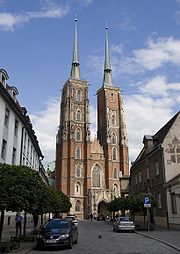 |
| Church of the Holy Cross | 1288-first half of the 14th century | |||
| Church of St. Elisabeth | 1309–1387 |  |
||
| Church of St. Mary Magdalen | 1355–1360 | |||
| City hall | 13th century, 15th century alterations, 19th century additions | Dominated by Neogothic design | ||
RussiaRussiaRussia or , officially known as both Russia and the Russian Federation , is a country in northern Eurasia. It is a federal semi-presidential republic, comprising 83 federal subjects...
| Place | Building | Main period of construction | Special features | Image |
| Kaliningrad Kaliningrad Kaliningrad is a seaport and the administrative center of Kaliningrad Oblast, the Russian exclave between Poland and Lithuania on the Baltic Sea... (Königsberg, East Prussia) |
Cathedral Königsberg Cathedral Königsberg Cathedral is a Brick Gothic style building in Kaliningrad on an island in the Pregel . The island was called Kneiphof in German times.-14th Century to World War II:... |
14th century | 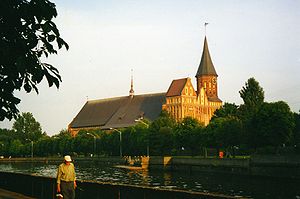 |
|
| Rodniki (Arnau, East Prussia) | Arnau Church Arnau Church The Arnau Church of St. Catherine of Alexandria is a Brick Gothic church 8 km east of Kaliningrad near the Pregolya River and the Russian-Lithuanian border. It was built in the 14th century in the East Prussian village of Arnau and contains more than 200 medieval frescoes. The Soviets used the... |
Late 14th century | ||
| Druzhba (Allenburg, East Prussia) | Allenburg Church Allenburg Church The Allenburg Church is a Brick Gothic building established near Allenburg Castle by Konrad von Jungingen, the Grand Master of the Teutonic Knights, in 1405. Seriously damaged during the First World War, the medieval building was restored and slightly expanded in 1925. After the Second World War,... |
15th century | ||
| Neman Neman (town) Neman is a town and the administrative center of Nemansky District of Kaliningrad Oblast, Russia. It is located in the historic Prussia region, east of the town of Sovetsk, on the steep southern bank of the Neman River, where it currently forms the border with the Klaipėda Region in... (Ragnit, East Prussia) |
Ordensburg | 1397–1409 | One of the strongest Ordensburgen. Now ruined. Built by Nikolaus von Fellenstein (see Malbork) | 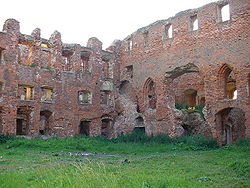 |
| Vesyoloye (Balga, East Prussia) | Ordensburg Balga Balga Balga was a medieval castle of the Teutonic Knights. Its ruins are in the Pogranichny municipality, Bagrationovsky District in Kaliningrad Oblast, Russia; located on the shore of the Vistula Lagoon north of Mamonovo, about southwest of Kaliningrad.... |
Circa 1239 | Ruin | 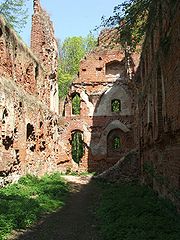 |
SwedenSwedenSweden , officially the Kingdom of Sweden , is a Nordic country on the Scandinavian Peninsula in Northern Europe. Sweden borders with Norway and Finland and is connected to Denmark by a bridge-tunnel across the Öresund....
| Place | Building | Main period of construction | Special features | Image |
| Danmark parish, east of Uppsala | Danmark Church | 14th and 15th century | ||
| Helsingborg Helsingborg Helsingborg is a city and the seat of Helsingborg Municipality, Skåne County, Sweden with 97,122 inhabitants in 2010. Helsingborg is the centre of an area in the Øresund region of about 320,000 inhabitants in north-west Scania, and is Sweden's closest point to Denmark, with the Danish city... |
St. Mary (Swedish: Sankta Maria kyrka) |  |
||
| Lund Lund -Main sights:During the 12th and 13th centuries, when the town was the seat of the archbishop, many churches and monasteries were built. At its peak, Lund had 27 churches, but most of them were demolished as result of the Reformation in 1536. Several medieval buildings remain, including Lund... |
St. Peter's Priory Church St. Peter's Priory, Lund St. Peter's Priory , or the Priory of St. Peter and St. Mary, was one of Denmark's early monastic houses. It was located in Lund, Skåne, now southern Sweden, formerly part of Denmark.- History :... (Swedish: Sankt Peters klosterkyrka) |
Circa 1300 | ||
| Malmö Malmö Malmö , in the southernmost province of Scania, is the third most populous city in Sweden, after Stockholm and Gothenburg.Malmö is the seat of Malmö Municipality and the capital of Skåne County... |
St. Peter St Petri, Malmö The Church of Saint Peter is a large church in Malmö. Construction was started in 1319. It is built in the Gothic style and has a 105-metre tall tower.-References:... (Swedish: Sankt Petri kyrka) |
 |
||
| Ronneby Ronneby Ronneby is a locality and the seat of Ronneby Municipality in Blekinge County, Sweden with 11,767 inhabitants in 2005.Ronneby is regarded as the heart of "the Garden of Sweden", and in 2005 the park "Brunnsparken" in Ronneby was voted Sweden's most beautiful park. 2006 the park was voted Europe's... |
Holy Cross Church (Swedish: Heliga Kors kyrka) | |||
| Sigtuna Sigtuna Sigtuna is a locality situated in Sigtuna Municipality, Stockholm County, Sweden with 18 inhabitants in 2005. It is the namesake of the municipality even though the seat is in Märsta.... |
St. Mary (Swedish: Mariakyrkan) | Mid 13th century | ||
| Skänninge Skänninge Skänninge is a locality situated in Mjölby Municipality, Östergötland County, Sweden with 3,242 inhabitants in 2005. It lies about 10 km north of the municipal seat Mjölby.... |
Vårfrukyrkan ("Church of Our Lady") | |||
| Skokloster north of Sigtuna | Skokloster Church (originally a convent church: Sko klosters kyrka "Sko Convent Church") | 13th century | Near Skokloster Castle Skokloster Castle Skokloster Castle is located on Lake Mälaren between Stockholm and Uppsala. It was built in the Baroque style between 1654 and 1676 by the wealthy military commander and count Carl Gustaf Wrangel. The castle was designed by architect Nicodemus Tessin the Elder... |
|
| Söderköping Söderköping Söderköping is a locality and the seat of Söderköping Municipality, Östergötland County, Sweden with 6,951 inhabitants in 2005. Söderköping is, despite its small population, for historical reasons normally still referred to as a city... |
St. Lawrence's Church (Swedish: S:t Laurentii kyrka) | |||
| Stockholm Stockholm Stockholm is the capital and the largest city of Sweden and constitutes the most populated urban area in Scandinavia. Stockholm is the most populous city in Sweden, with a population of 851,155 in the municipality , 1.37 million in the urban area , and around 2.1 million in the metropolitan area... |
Riddarholmen Church (Swedish: Riddarholmskyrkan) | Late 13th century, major 15th, 16th, 17th, 18th and 19th century alterations | Burial church for many of the Swedish monarchs | 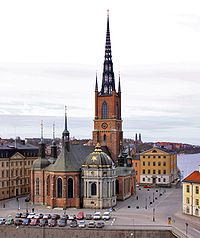 |
| Storkyrkan Storkyrkan Sankt Nikolai kyrka , most commonly known as Storkyrkan and Stockholms domkyrka , is the oldest church in Gamla Stan, the old town in central Stockholm, Sweden. It is an important example of Swedish Brick Gothic... (St. Nicholas) |
13th to 15 th century, major 18th century external alterations | Outside altered into baroque stucco structure in 1736-1742 to make it more similar to the Royal Palace Stockholm Palace The Stockholm Palace is the official residence and major royal palace of the Swedish monarch. . Stockholm Palace is located on Stadsholmen , in Gamla Stan in the capital, Stockholm... nearby, which was being constructed at that time after a big fire in 1697. Brick gothic interior is however preserved - it contains late gothic monumental sculpture of St. George and the dragon by Bernt Notke Bernt Notke ' was the most important German painter and sculptor in Northern Europe in his times.... . It is the wedding and coronation church of many Swedish royalties |
.jpg) |
|
| Strängnäs Strängnäs Strängnäs is a locality and the seat of Strängnäs Municipality, Södermanland County, Sweden with 12,296 inhabitants in 2005. It is located by Lake Mälaren and is the episcopal see of the Diocese of Strängnäs, a former Roman Catholic and present Lutheran Diocese, with the Strängnäs Cathedral, built... |
Strängnäs Cathedral Strängnäs Cathedral Strängnäs Cathedral is a cathedral church in Strängnäs, Sweden, since the Protestant Reformation the seat of the Lutheran Diocese of Strängnäs.It is built mainly of bricks in the characteristic Scandinavian Brick Gothic style... |
1296 onwards |  |
|
| Tensta parish, north of Uppsala | Tensta Church | |||
| Uppsala Uppsala - Economy :Today Uppsala is well established in medical research and recognized for its leading position in biotechnology.*Abbott Medical Optics *GE Healthcare*Pfizer *Phadia, an offshoot of Pharmacia*Fresenius*Q-Med... |
Uppsala Cathedral Uppsala Cathedral Uppsala Cathedral is a cathedral located centrally in the city of Uppsala, Sweden. It dates back to the late 13th century and at a height of 118.7 m is the tallest church building in Scandinavia. Originally built under Roman Catholicism and used for coronations of the Swedish monarch, since the... |
1287–1435, major 18th and 19th century alterations | External appearance largely 19th century |  |
| Holy Trinity Church (Swedish: Helga trefaldighets kyrka) | Late 13th to 15th century | |||
| Vadstena Vadstena Vadstena is a locality and the seat of Vadstena Municipality, Östergötland County, Sweden, with 5,612 inhabitants in 2005. From 1974 to 1979 Vadstena was administered as part of Motala Municipality.... |
House of Mårten Skinnare | Late Middle Ages, 18th century alterations | The roof was lowered and the crow-stepped gable Crow-stepped gable A Stepped gable, Crow-stepped gable, or Corbie step is a stair-step type of design at the top of the triangular gable-end of a building... s removed in the 18th century. |
|
| Former royal palace, then part of Vadstena Abbey Vadstena Abbey Vadstena Abbey was the motherhouse of the Bridgettine Order, situated on Lake Vättern, in the Diocese of Linköping, Sweden. The abbey started as one of the farms donated by the king, but the town of Vadstena grew up around it... and later a hospital |
Mid 13th century, 14th century alterations | When handed over to the abbey in 1346 the building was "humbled" and the roof was lowered. | ||
| Västerås Västerås Västerås is a city in central Sweden, located on the shore of Lake Mälaren in the province Västmanland, some 100 km west of Stockholm... |
Västerås Cathedral | 13th century, 14th and 15th century extensions and later alterations | Burial place of Eric XIV of Sweden Eric XIV of Sweden -Family and descendants:Eric XIV had several relationships before his marriage. With Agda Persdotter he had four daughters:#Margareta Eriksdotter , married 1592 to Olov Simonsson, vicar of Horn.... |
|
| Ystad Ystad Ystad is a "locality", or town, and the seat of Ystad Municipality, Skåne County, Sweden, with 17,286 inhabitants .Settlement dates back to the 11th century and the town has become a busy ferryport, local administrative centre and tourist attraction... |
St. Mary (Swedish: Sankta Maria kyrka) | 13th to 15th century |  |
|
| Franciscan Monastery Church (St. Peter)(Swedish: S:t Petri kyrka) | Late 13th to 15th century |  |
||
UkraineUkraineUkraine is a country in Eastern Europe. It has an area of 603,628 km², making it the second largest contiguous country on the European continent, after Russia...
| Place | Building | Main period of construction | Special features | Image |
| Łuck | Lubart's Castle Lubart's Castle Lutsk High Castle, also known as Lubart's Castle, began its life in the mid-14th century as the fortified seat of Gediminas' son Liubartas , the last ruler of united Galicia-Volhynia. It is the most prominent landmark of Lutsk, Ukraine and as such appears on the 200 hryvnia bill... (Polish: Zamek w Łucku, Ukrainian: Луцький замок) |
14th and 15th century | ||
| Zimno | Zymne Monastery Zymne Monastery The Uspensky Svyatogorsky Monastery is a stauropegial Ukrainian Orthodox cave monastery, located at the top of the Holy Mountain rising above the Luh River near the village of Zymne, five kilometers south of Volodymyr-Volynskyi, Volyn Oblast, Ukraine.- History :The origin of the monastery is... (Polish: Monaster Zaśnięcia Matki Bożej w Zimnem, Ukrainian: Зимненський монастир) |
after 1495 | ||

